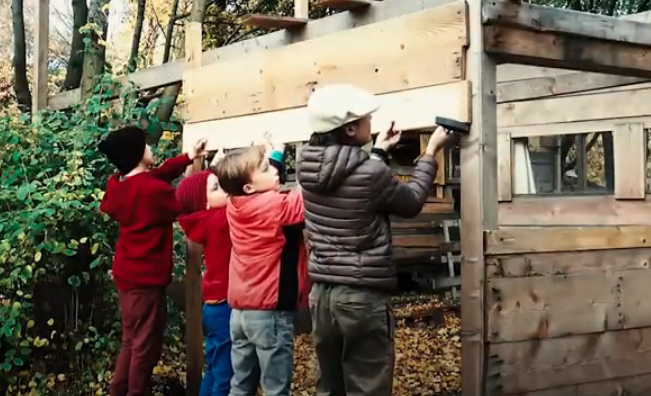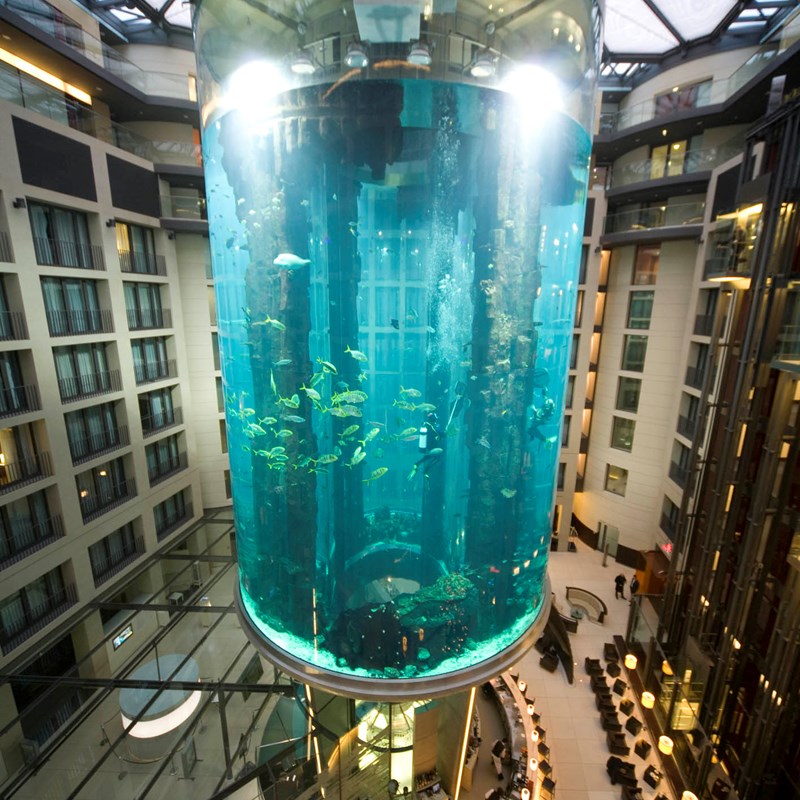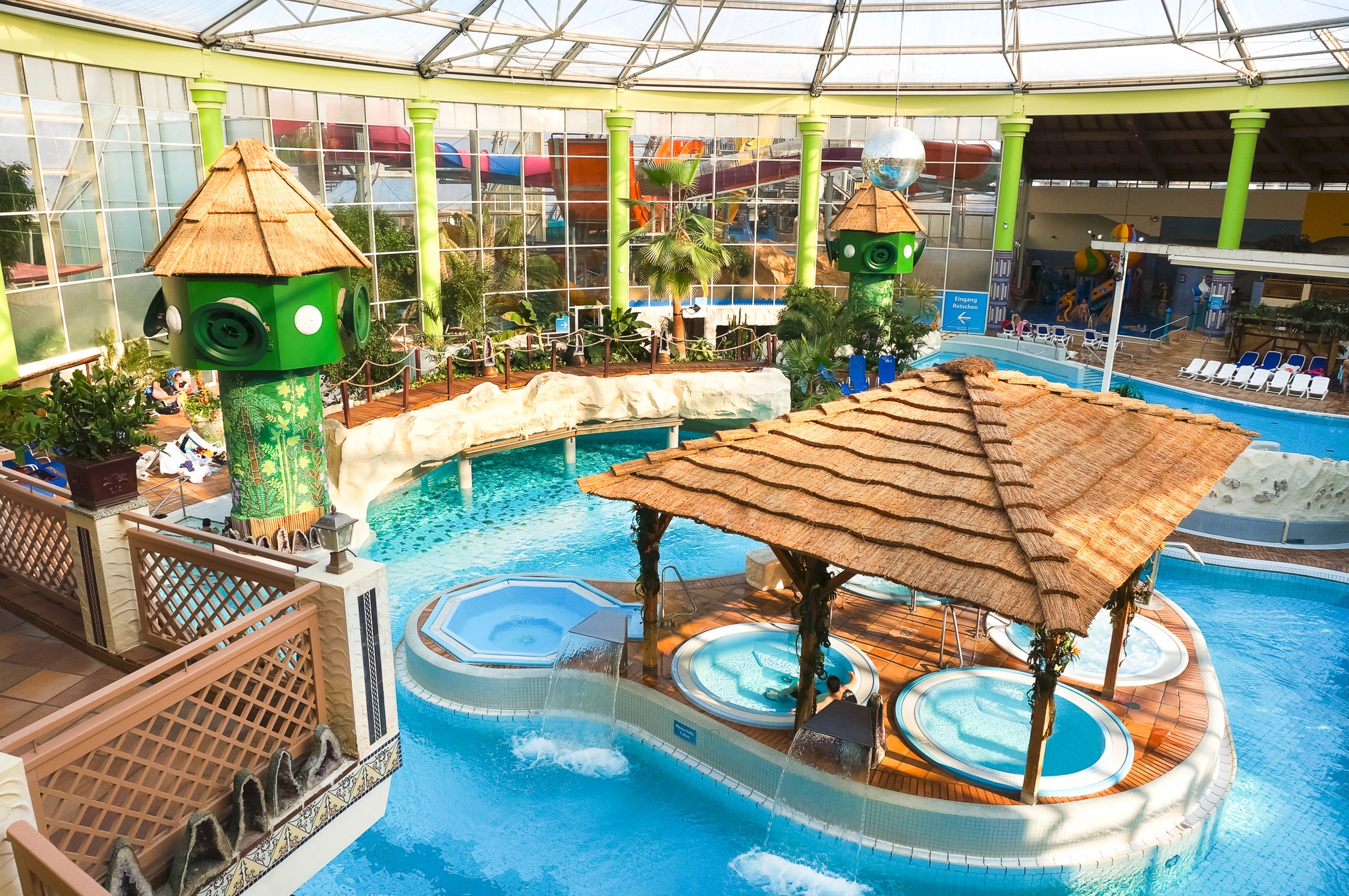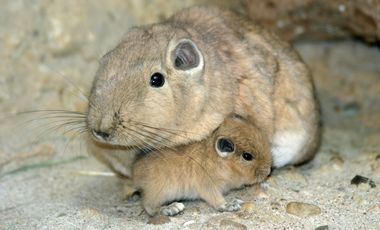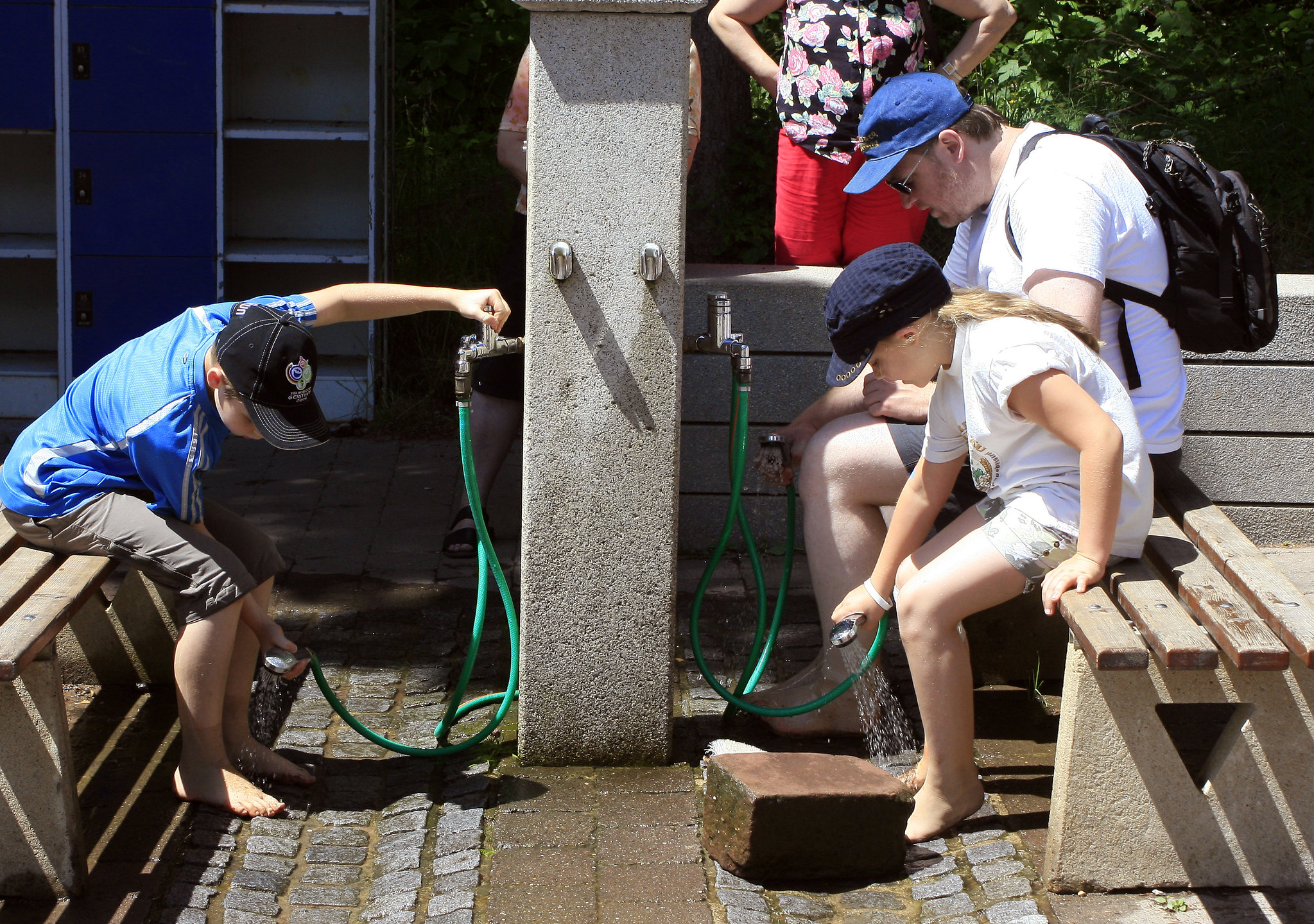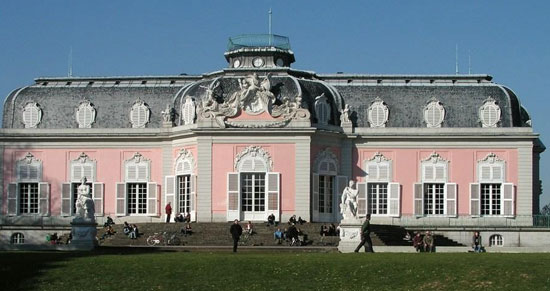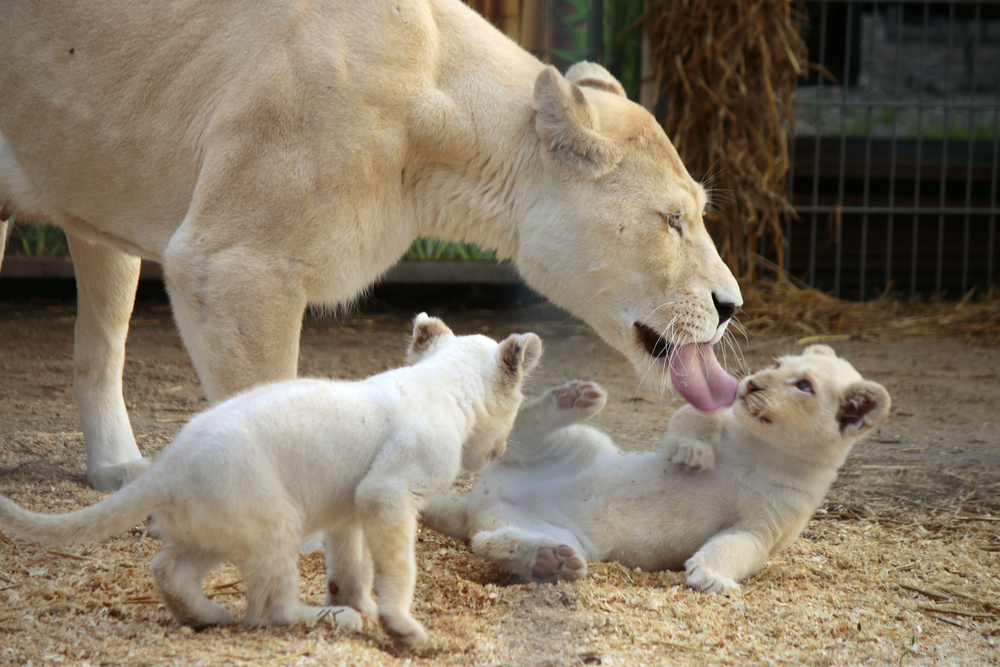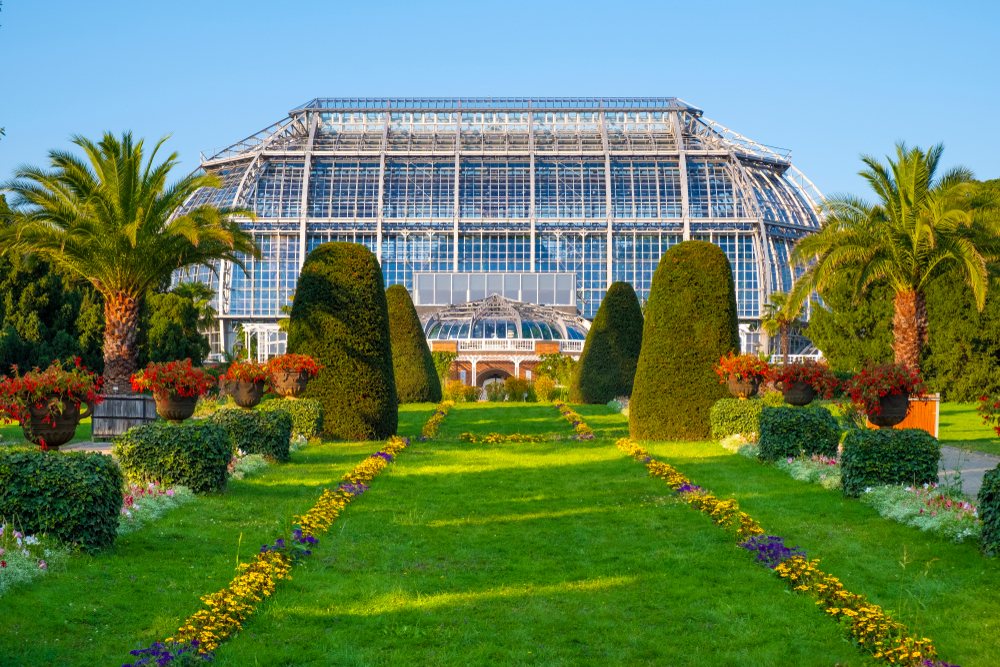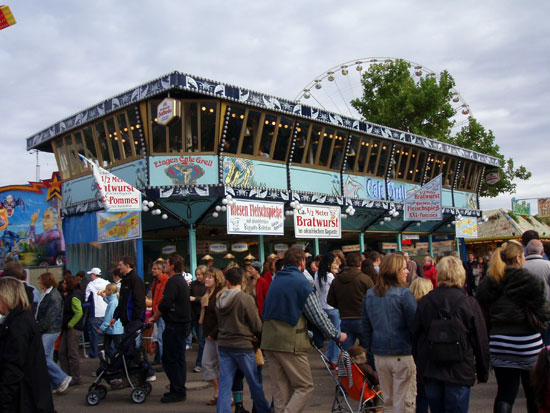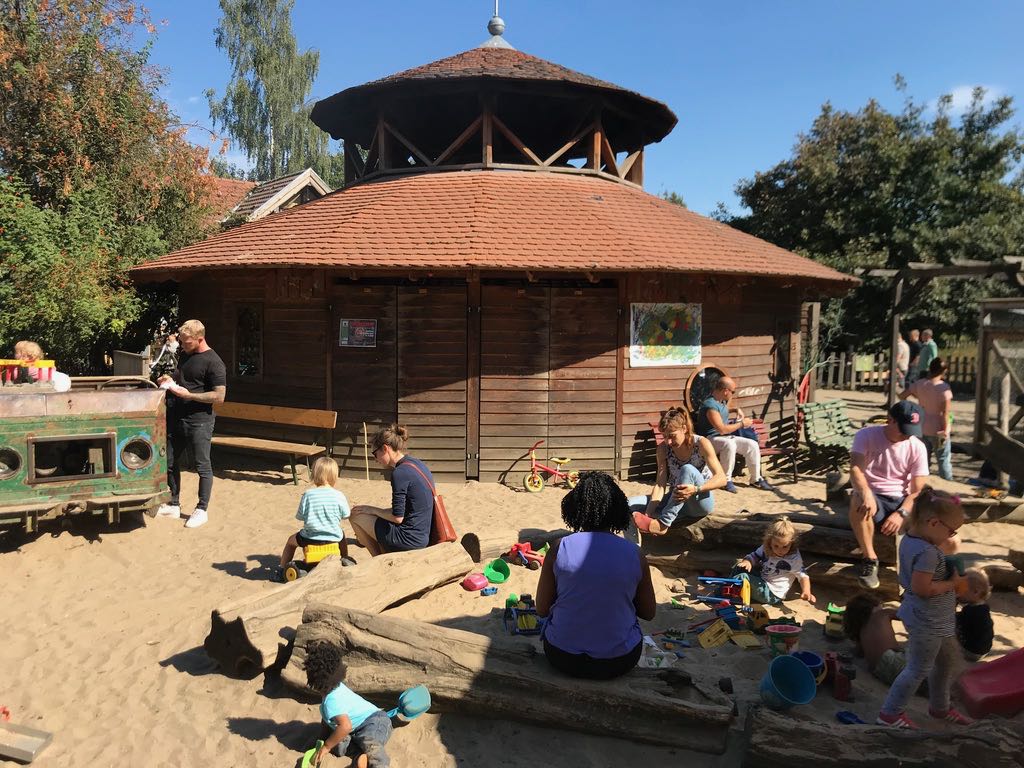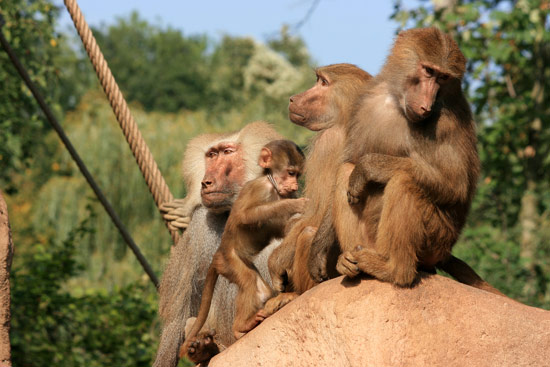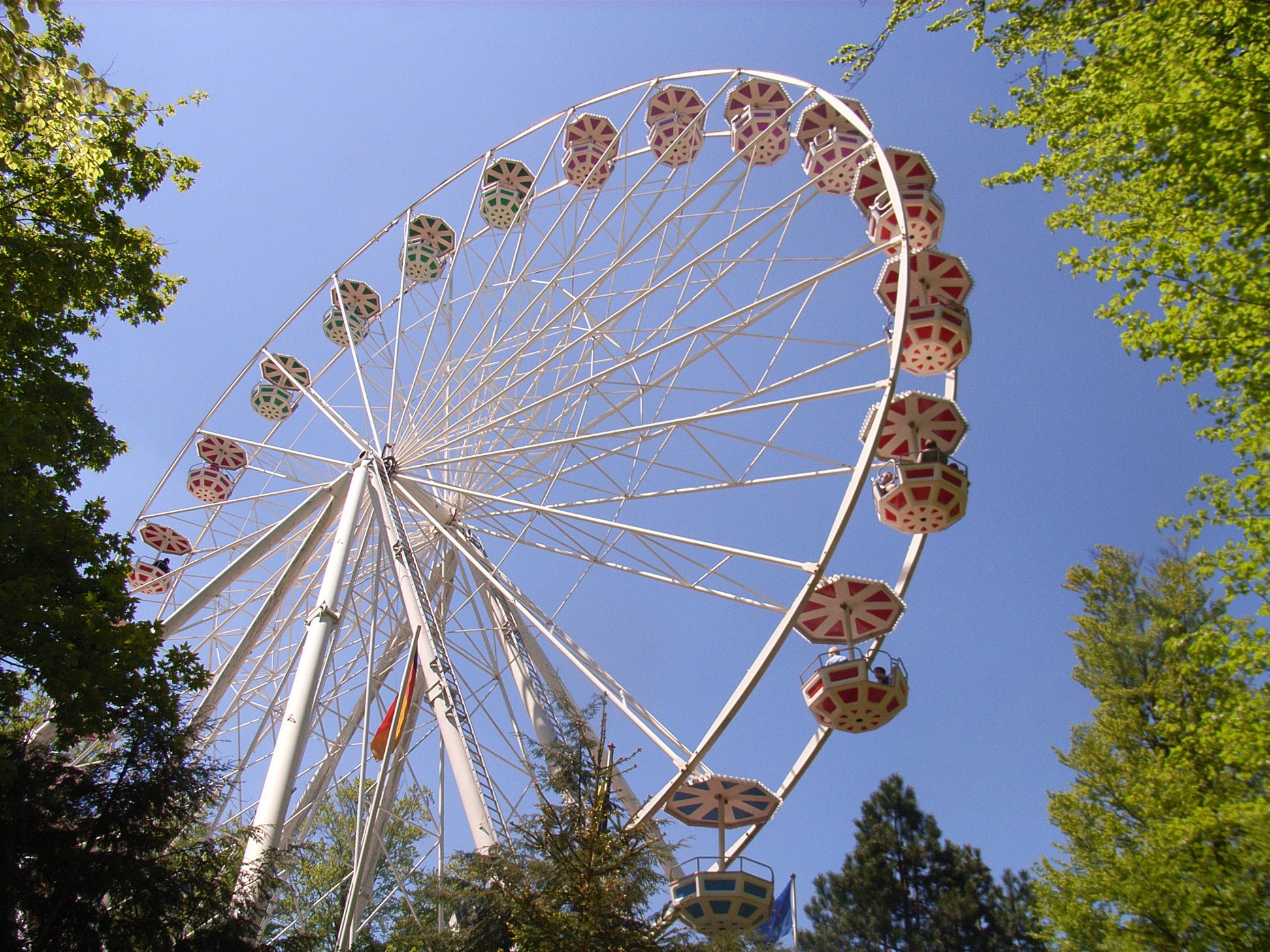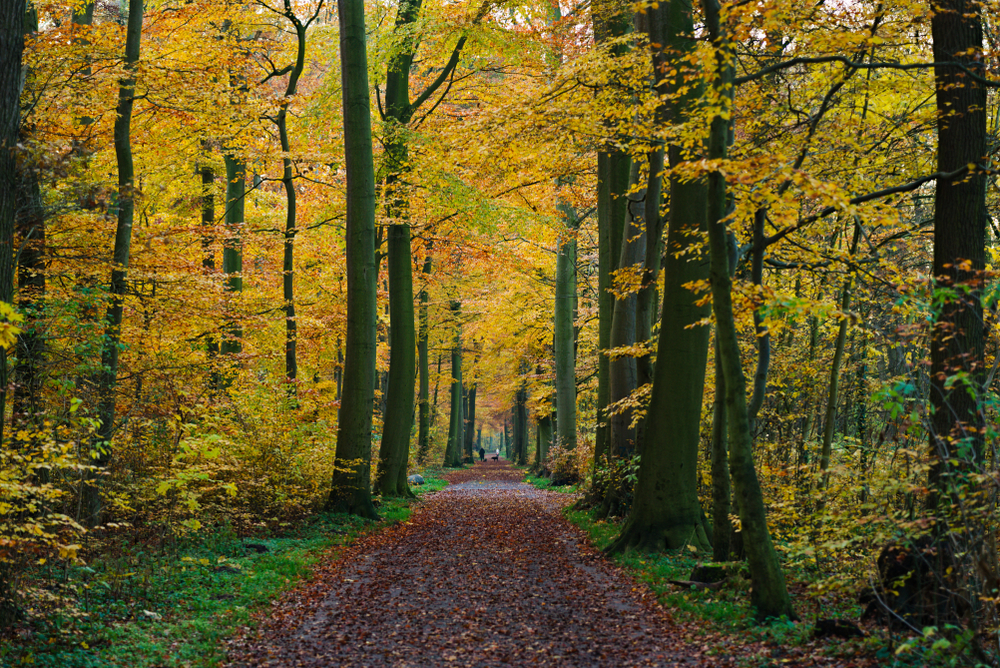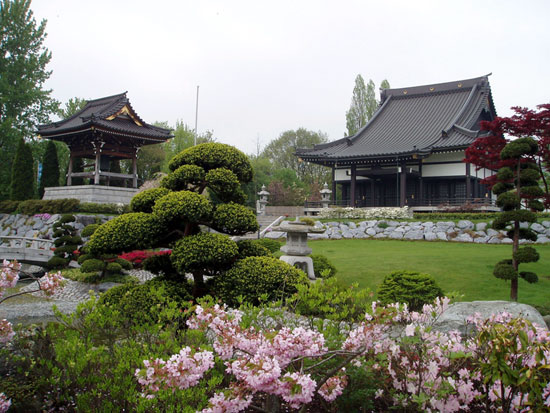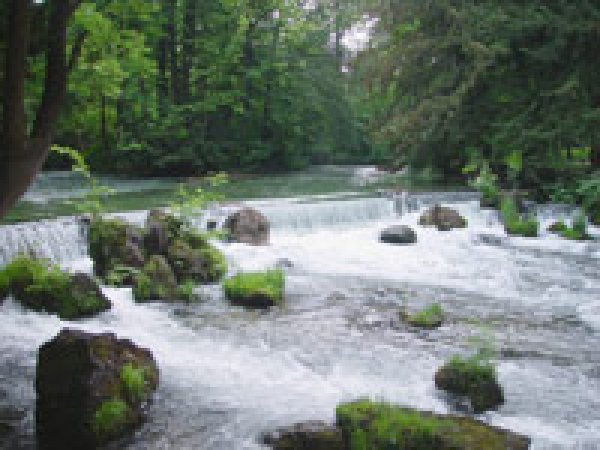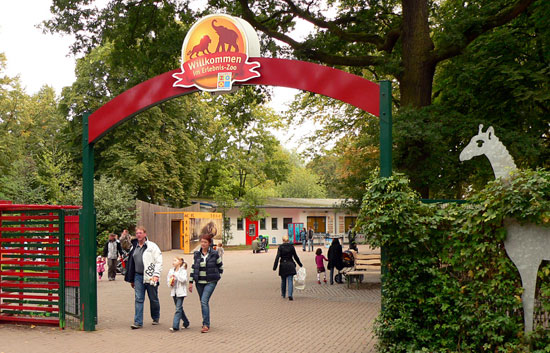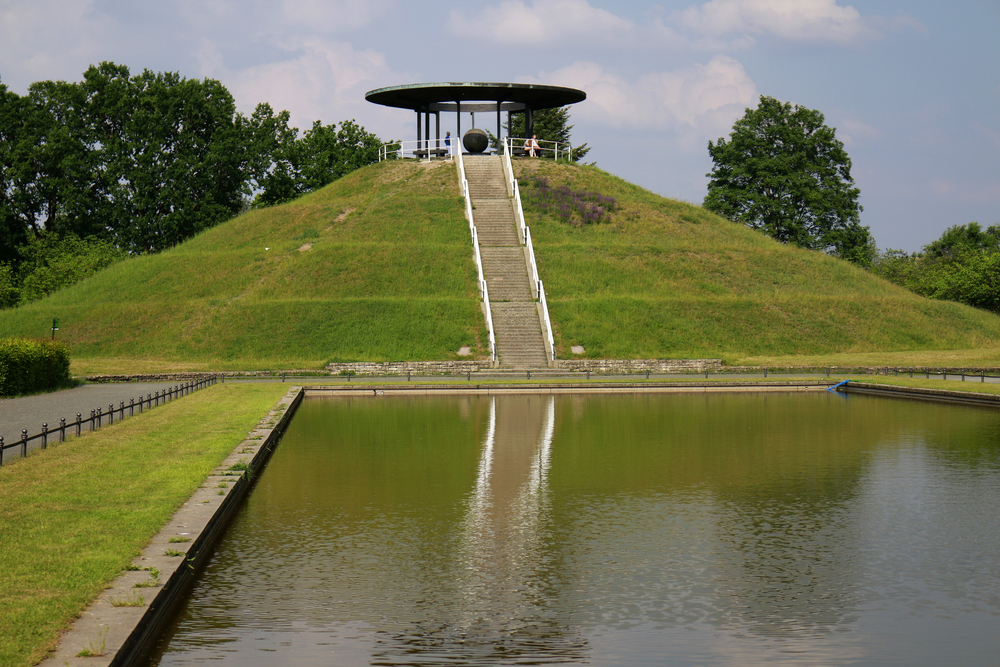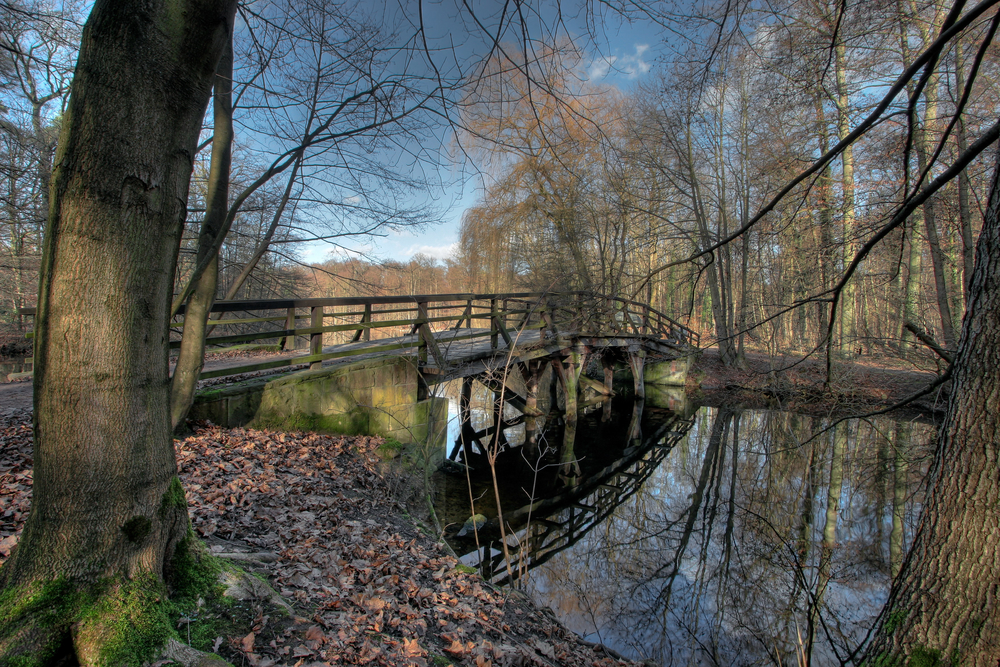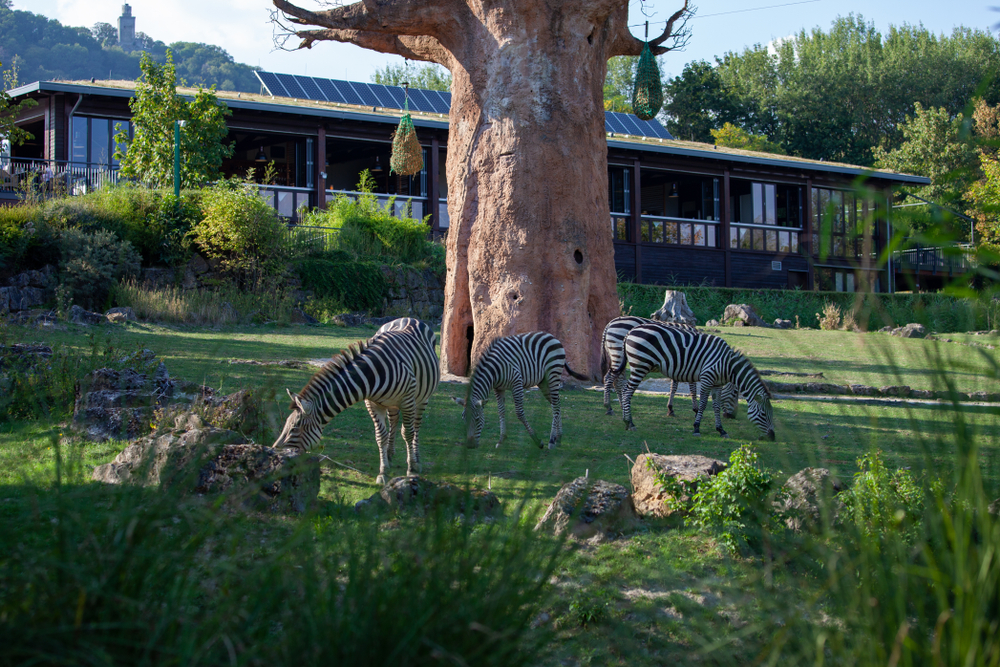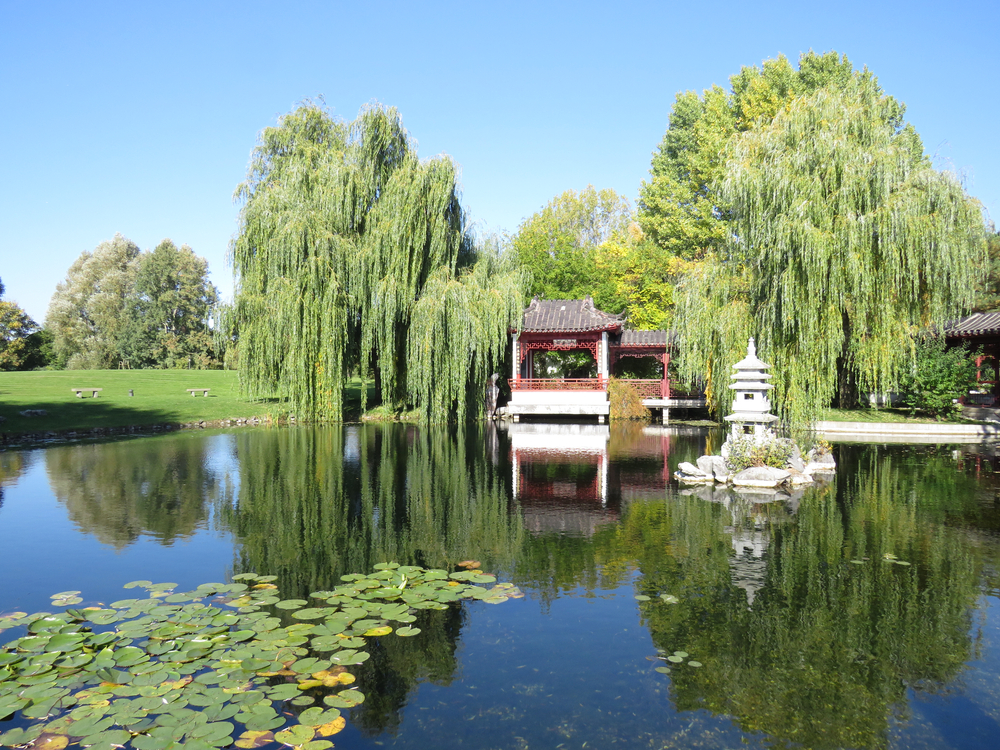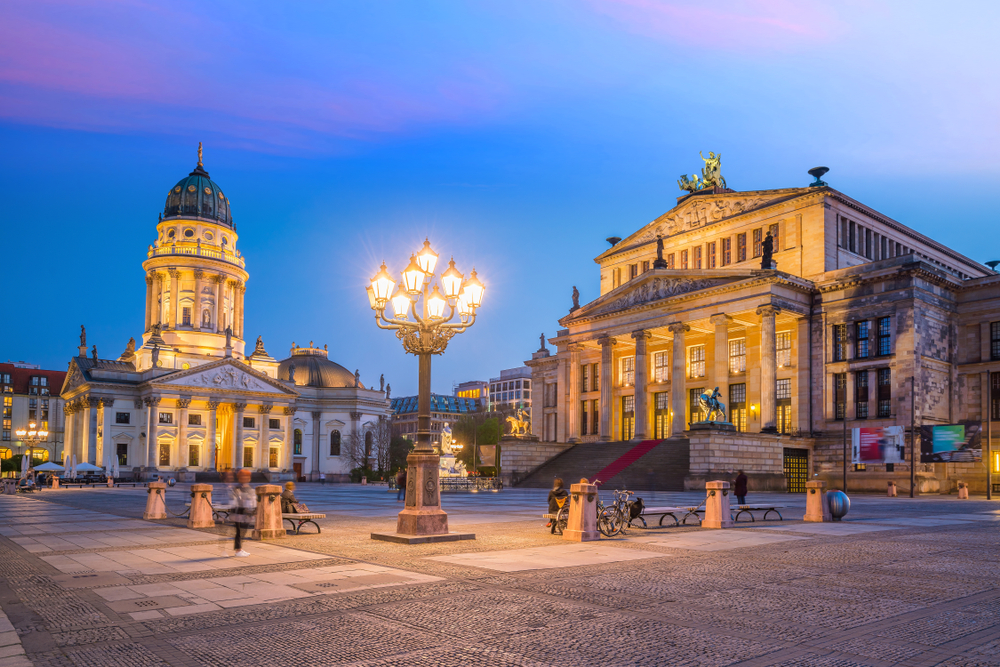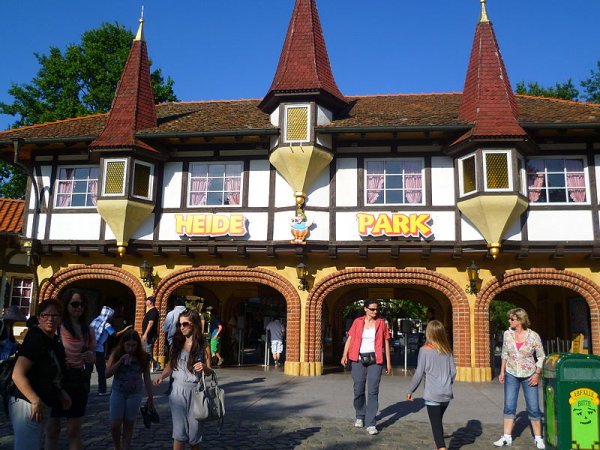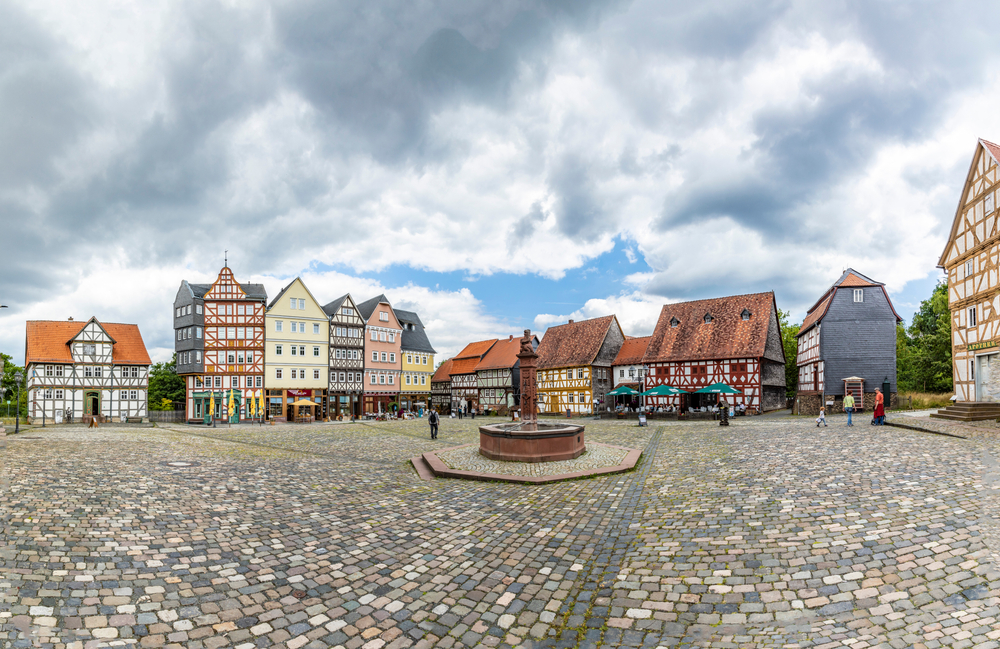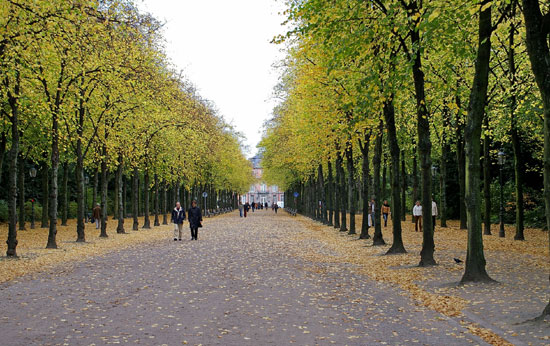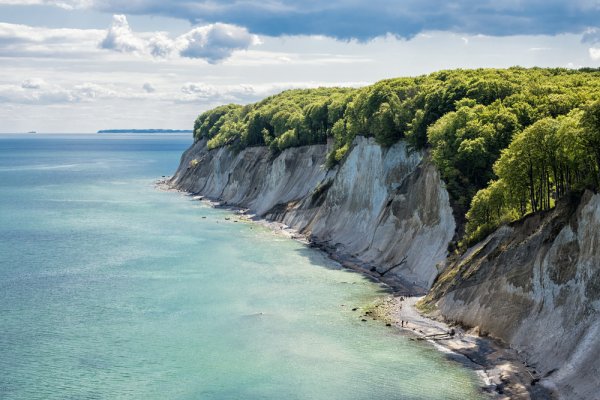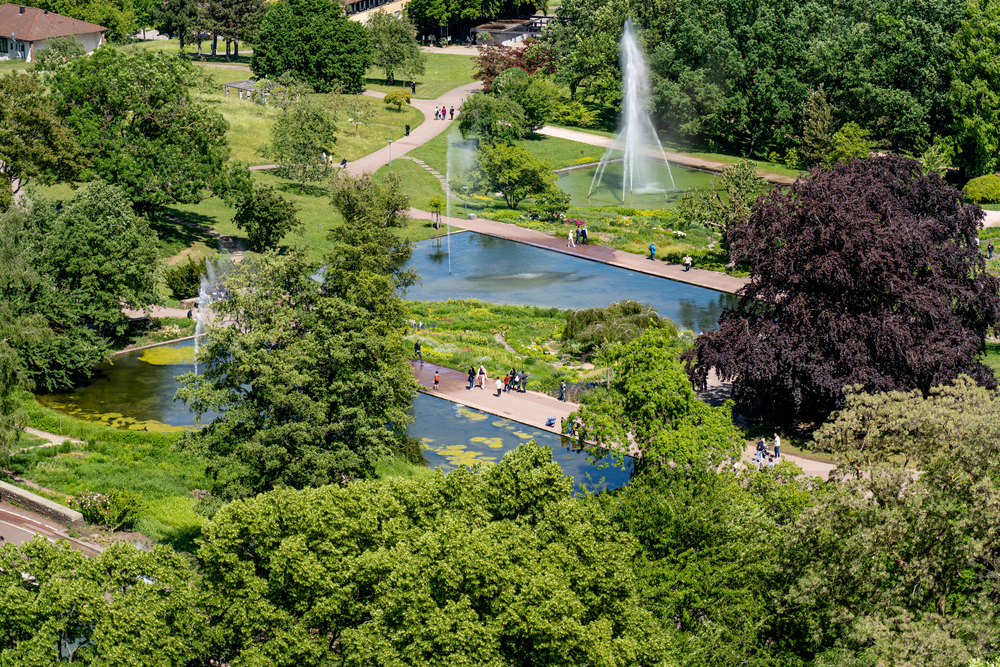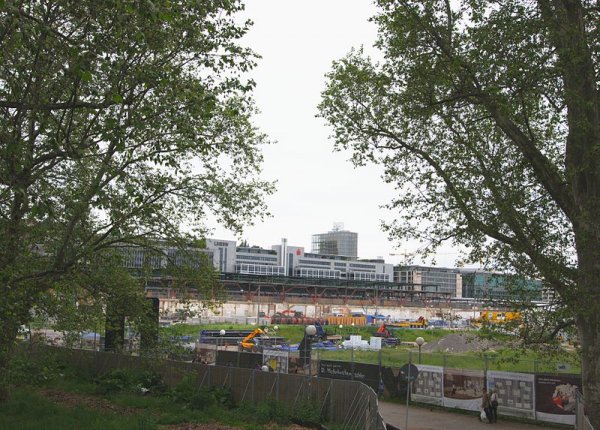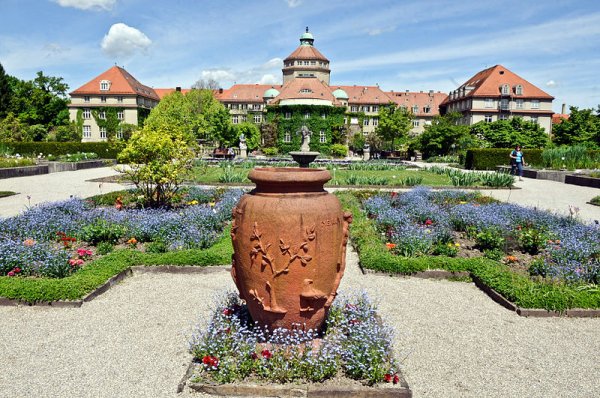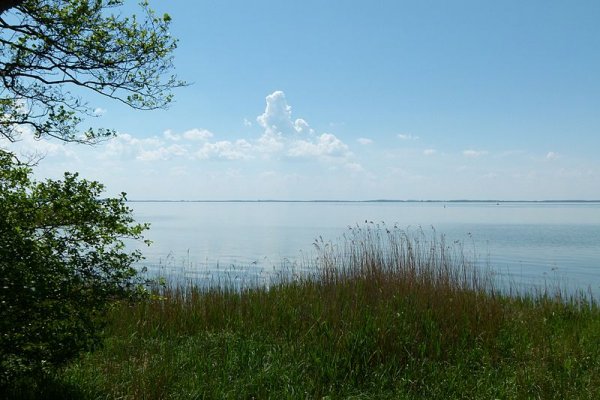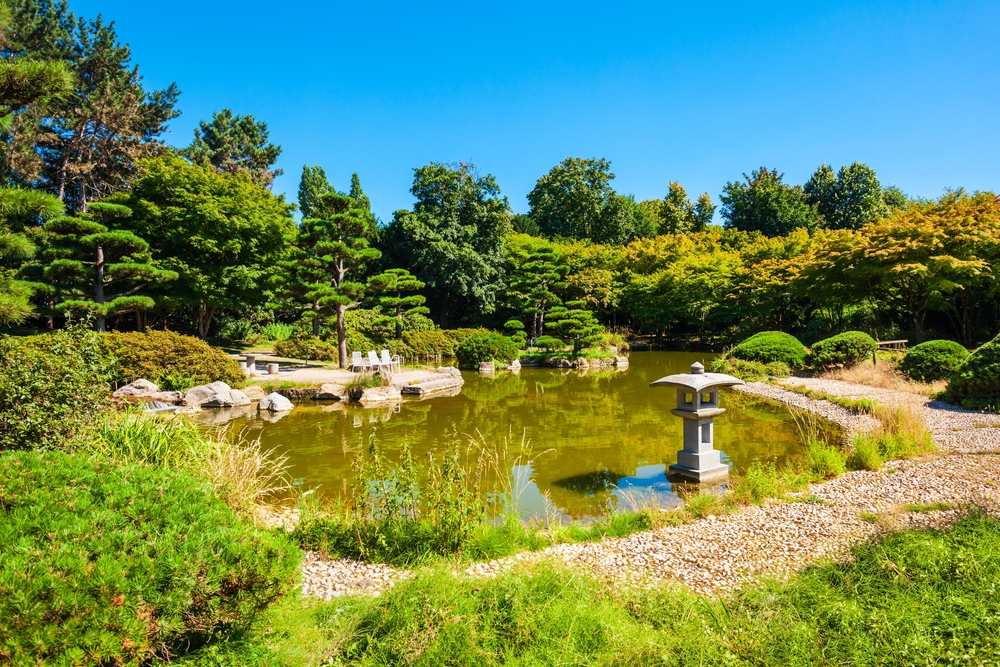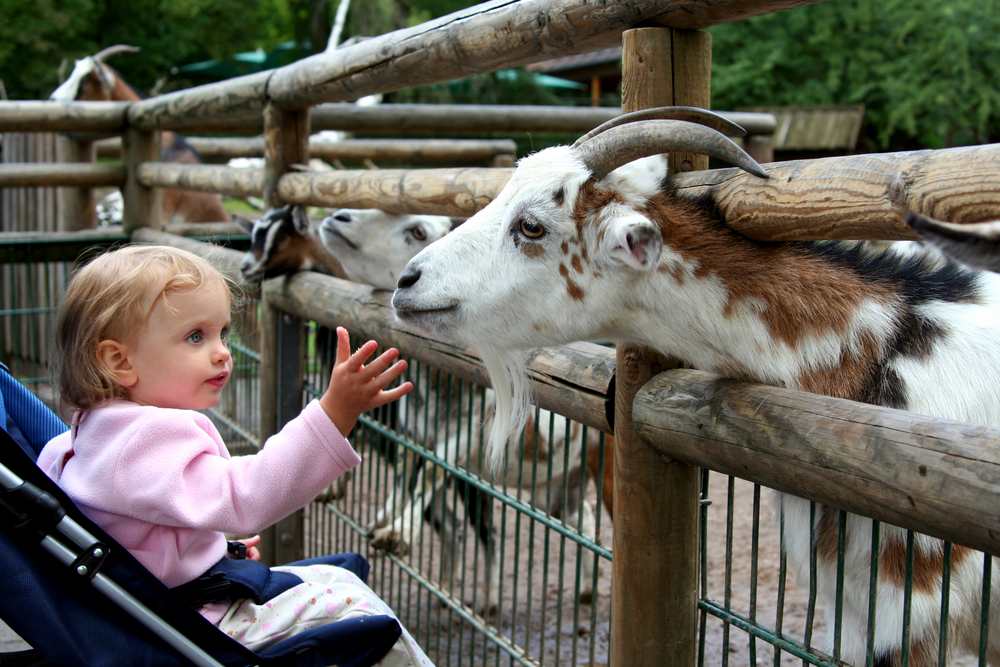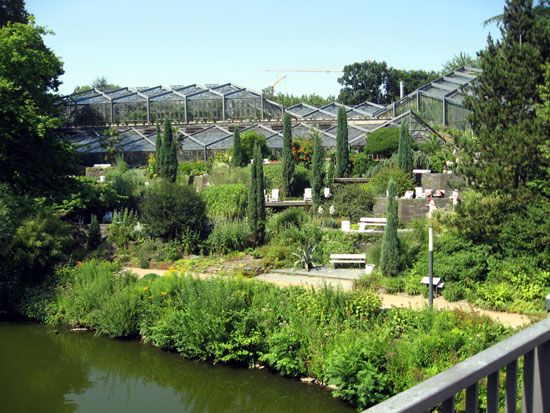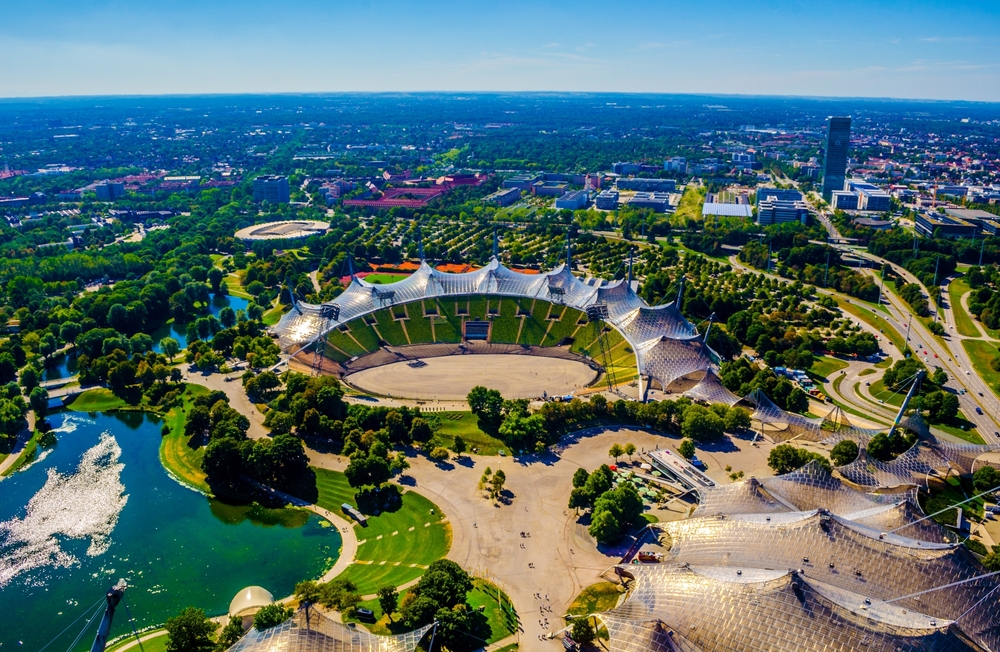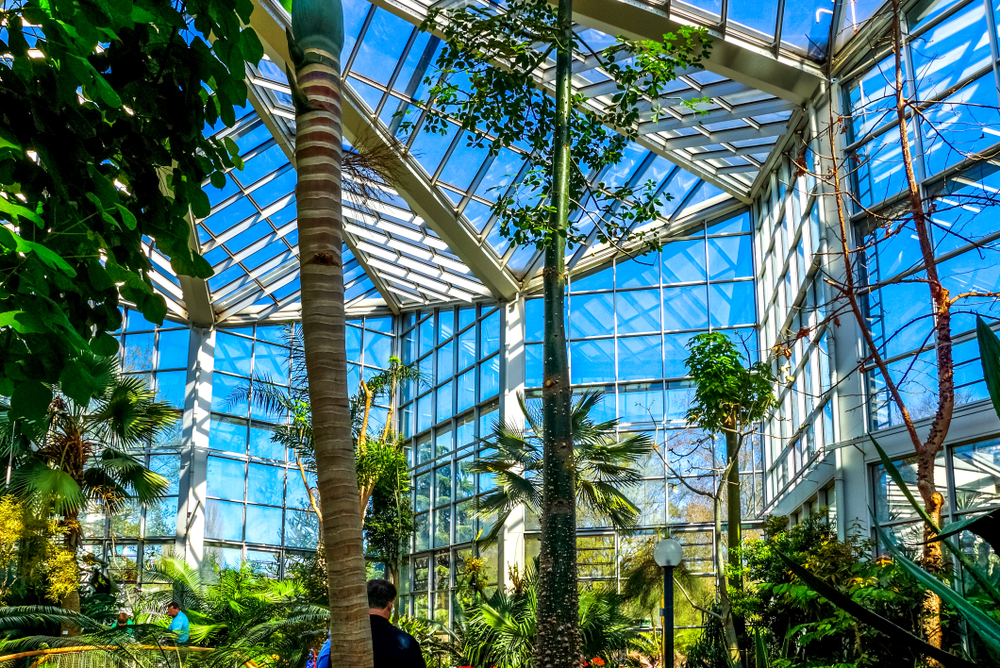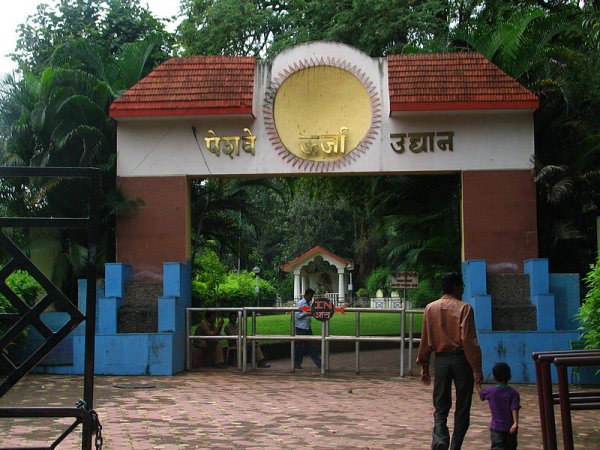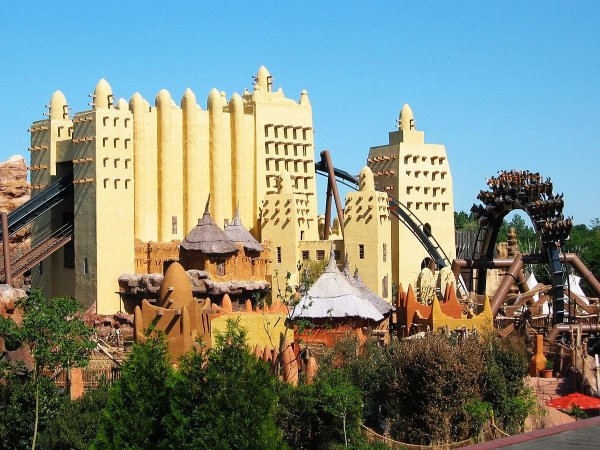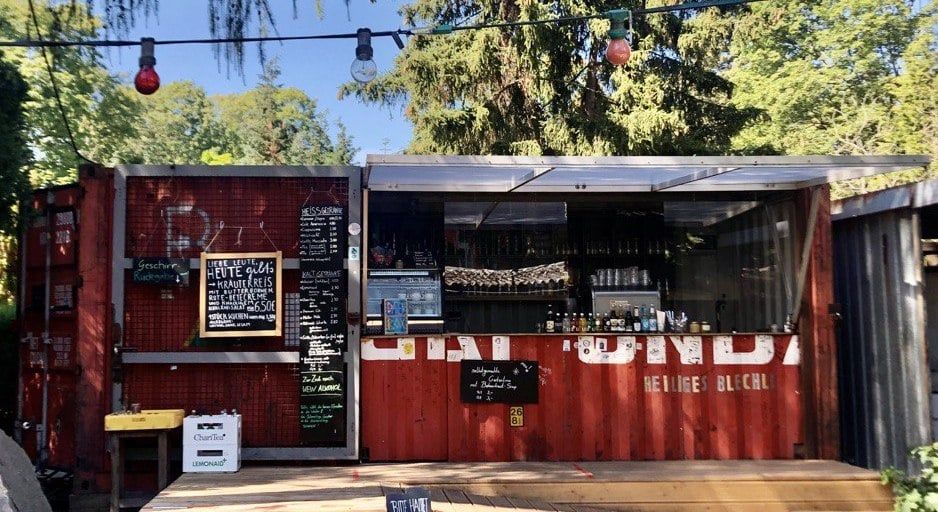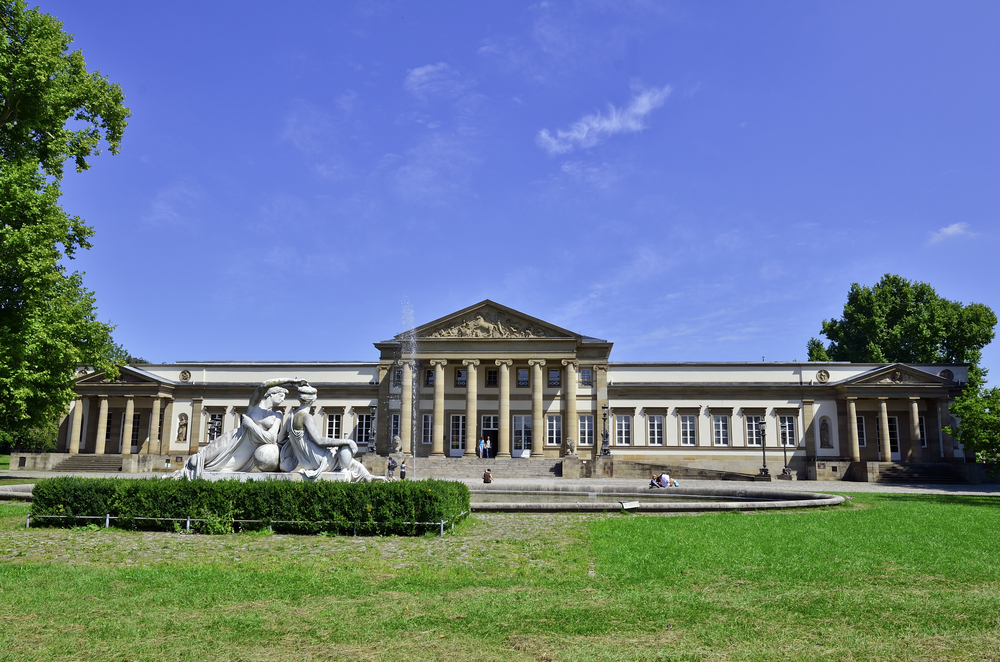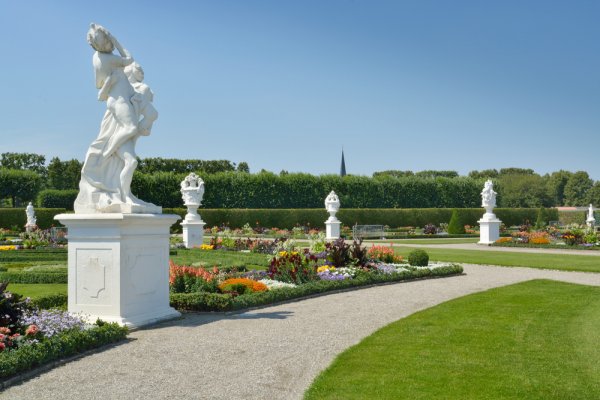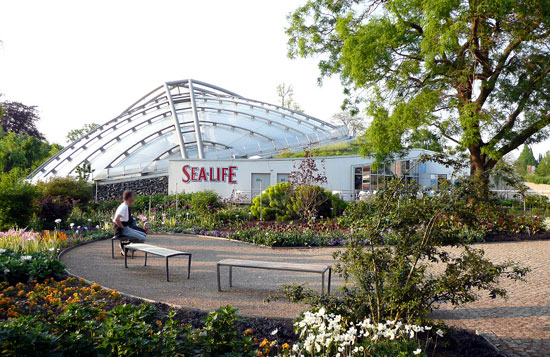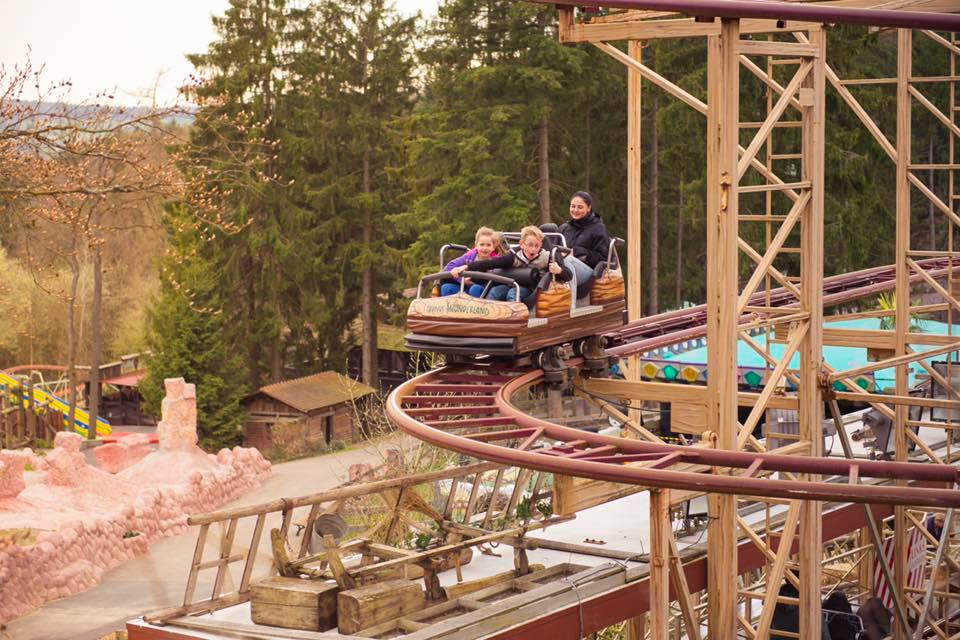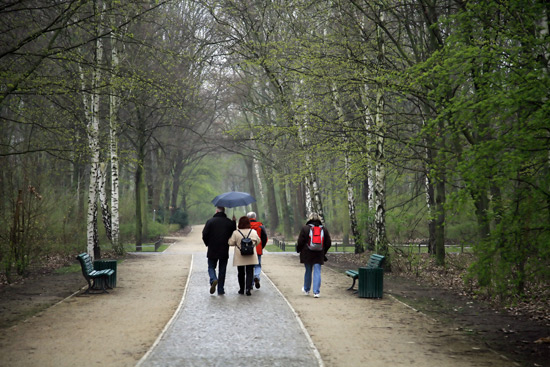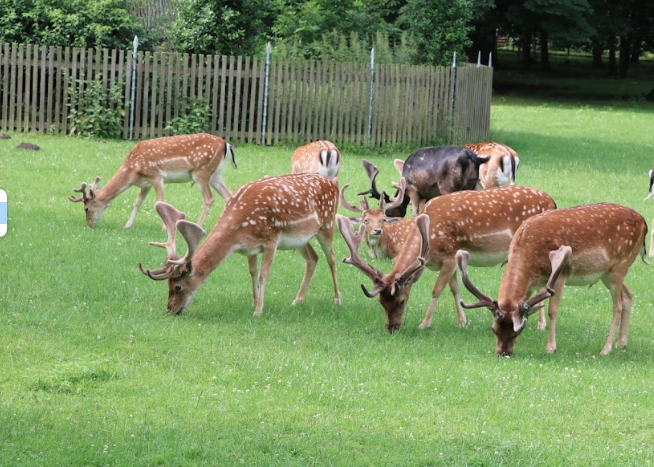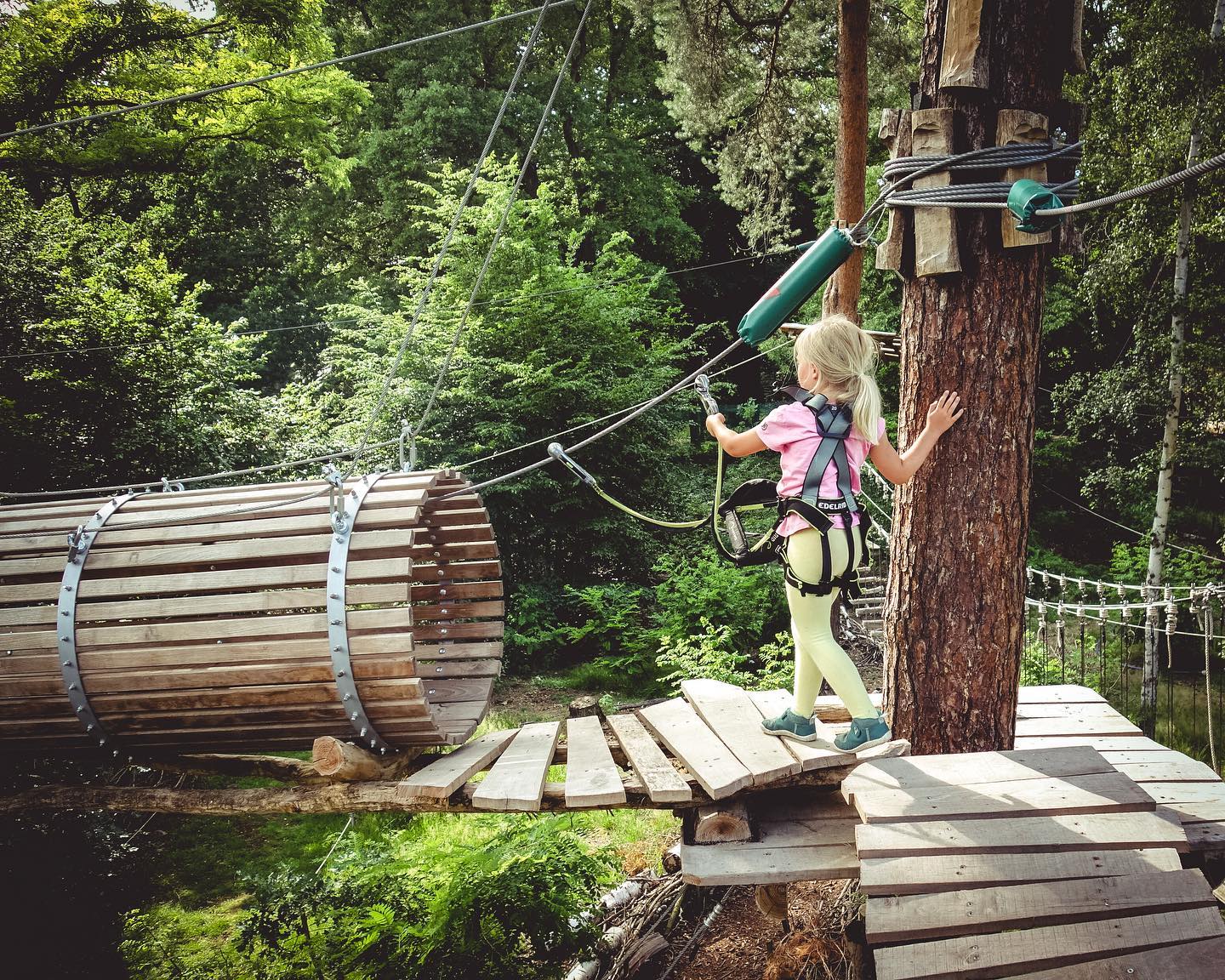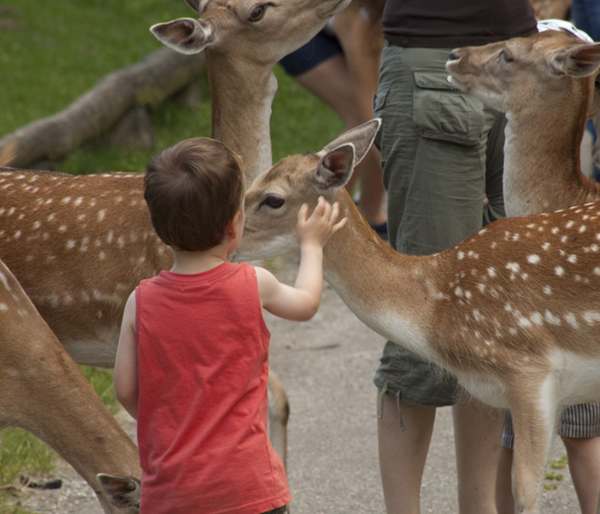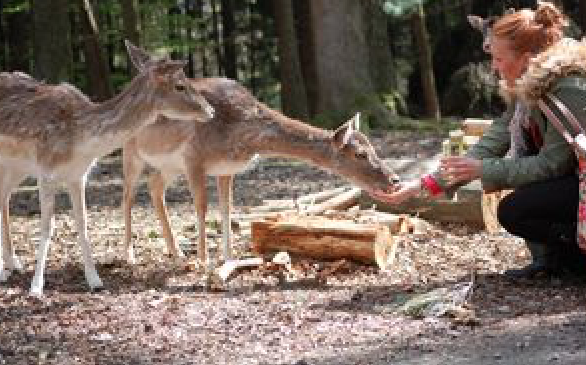Points of Interest
Adventure Playground EV
Abenteuerspielplatz Bruggener Weg 8
40547 Dusseldorf, Germany
Options abound for ages 6 to 14 at this expansive adventure playground. Covering 10,000 square meters (107,640 square feet), there are fields and courts to play football, basketball, and table tennis, while kids interested in climbing can try bouldering. The playground includes paid staff so there is adult supervision for children and teens to try their hand at making a fire, pottery, or building items in the construction zone. Seasonal special events are offered that include cooking and making handicrafts. One area includes animals that children can visit and learn to care for. With all the space available, kids can also enjoy unstructured playtime and run, jump, and swing. Entrance to the playground is free.
AquaDom and SEA LIFE Berlin
Spandauer Strasse 3
Berlin, Germany
Marvel at the sea’s amazing creatures in a translucent underwater world, at AquaDom and SEA LIFE Berlin. From clownfish and sea horses to jellyfish and stingrays, there’s hours of educational entertainment within. The AquaDom is a 25-meter-tall (82-foot-tall) cylindrical aquarium with a built-in transparent elevator. Other exhibits include Tropical Coral Reef, Depths of the Atlantic Ocean, Ray Bay, and areas specifically for octopus, sea horses, and jellyfish. Daily shows and feeding times offer more up-close experiences. Stop by the souvenir shop for a memento of your time here. Children ages 3 and under get in for free. Find the aquarium inside the Radisson Blu Hotel in the DomAquarée complex at Karl-Liebknecht-Strasse in central Berlin.
Aqualand
Merianstraße 1
50765 Cologne, Germany
An indoor waterpark, Aqualand offers a fun and refreshing escape for every member of the family. Plan for a full day of activity and time to explore the many unique offerings, like the Himalaya Sea Salt Grotto with more than 9,000 salt blocks. There are seven large slides, several pools, a paddling area for kids, water jets, and lazy river that flows outdoors. Free lockers are available, and a restaurant will keep the family fueled up. Parents have several choices when they’ve gotten their share of slippery thrills, as there’s an on-site spa offering a range of treatments including massages. There also are indoor and outdoor saunas offering warm relaxation and a pool bar too. Visit the website for more information and details on all the offerings as well as operating hours.
Aquazoo Löbbecke Museum
Kaiserswerther Straße 380
40474 Dusselfdorf, Germany
The Aquazoo Löbbecke Museum is a cultural and scientific institution that represents an inseparable link between zoo, aquarium, and natural history museum. In a unique synergy of living animals, vivid exhibits, and interactive media, it enables understanding the origin, evolution and diversity of animals and plants. On a tour of the themed rooms, you follow the evolution of living beings: from the emergence of life in water, the spread of organisms in the sea, the conquest of freshwater and the colonization of all habitats on land. Over 5,000 animals from more than 500 species, more than 1400 fascinating museum objects and interactive elements and media are waiting to be discovered.
– Information provided by Aquazoo Löbbecke Museum
Barefoot Park
Barfusspark Dornstetten-Hallwangen Silberwaldstraße 22
Dornstetten, Germany
Known as Barefoot Park, Barfusspark Hallwangen is where the shoes come off and the Earth’s natural textures are experienced. Travel along a 2.4-kilometer (1.5-mile) route with areas where wood, stone, mulch, grass, clay, and water offer a true sensory experience. Kids especially should enjoy the opportunity to freewheel in nature. Guides can accompany you along the trail or venture off to enjoy at your own speed. Head to the giant trampoline, rope pyramid, or the water adventure playground when you’ve experienced the trail. A barbecue and picnic area offers grills, shelter, and seating so come prepared with snacks or a meal. The park also is a great place for birthday parties. And don’t worry—there’s a foot washing station for when you’ve finishing squishing the mud between your toes. Find the park about 30 minutes southeast of Stuttgart in Dornstetten.
Benrath Palace
Schloss Benrath Benrath
Düsseldorf, Germany
In the south of the city lies the late-baroque castle Schloss Benrath, which features not only the Museum für Europäische Gartenkunst (Museum for European Garden Art) but also a spacious park with a mirroring pond, an English landscape park, and a French baroque garden on 60 hectares. Visitors can stroll around among old trees, sculptures, and flower and herb gardens.
Berlin Zoological Garden
Zoologischer Garten 8 Hardenbergplatz Berlin
Berlin 10787, Germany
Berlin Zoological Garden is the oldest surviving and best-known zoo in Germany. Opened in 1844, it covers 35 hectares (86.5 acres) and is located in Berlin's Tiergarten. Both the aquarium and the zoo are popular tourist attractions. Frederick William IV, King of Prussia, donated animals to start this zoo. Today it has a collection of about 20,200 animals from 1,380 species, including the rare giant panda. The zoo has a special breeding program for white and black rhinoceroses and gaurs. Annually, the zoo attracts around 3 million visitors from all over the world.
Botanic Garden and Botanical Museum Berlin
Königin-Luise-Straße 6-8
Berlin, Germany
See the world in one garden at Botanic Garden and Botanical Museum Berlin, a magical place that appeals to all the senses. Relax on the lakeshore, take a walk on picturesque paths—nature is always in season. One of the largest botanic gardens in the world, the 43 hectares (106 acres) encompasses 20,000 plant species. The Great Tropical House is an architectural masterpiece from the Art Nouveau era that includes palm trees, lianas, giant bamboo, and other plants from the Caribbean and Southeast Asia. Special greenhouses feature cactus, orchids, ferns, and bromeliads, while kids of all ages will be fascinated by a house just for carnivorous plants. Outdoors, visitors will find gardens of medicinal plants, a fragrance and touch garden, moss garden, swamp and water garden, and more. A two-level museum includes exhibits on plant and vegetable kingdoms and the tribal history of plants, among others, while the library is an additional attraction. Guided tours are available.
—Information provided by Botanic Garden and Botanical Museum Berlin
Cannstatter Meadow
Cannstatter Wasen Mercedes Straße 50
Stuttgart, Germany
This 350,000-square-meter meadow overlooks the glorious River Neckar in the spa territory of Bad Cannstatt. A section of it is devoted to a theme park, but Cannstatter Wasen really comes alive during the two annual festivals it hosts. Over 4 million people flock to the Volksfest (People's Festival), which began life as a harvest fair in 1818, but is now an enormous jamboree of traditional food, beer drinking, fairground rides, and fireworks. The strange but true Fruit Column-a tower decorated with apples, grapes, pears, and bananas-is now a permanent fixture of the meadow. Off-season, circuses pitch their colorful tents here and open-air concerts are played.
Children’s Farm Pinke Panke
Kinderbauernhof Pinke-Panke Am Bürgerpark 15-18
Berlin, Germany
This seasonal attraction lets kids see and touch farm animals and learn traditional crafts. Open from April through October, visit with donkeys, sheep, pigs, rabbits, chicken, cats, and other gentle animals. Kids can help with farm chores, feed the animals, hear from storytellers, and learn about where food comes from. Pinke Panke is a popular draw for Berliners, open for more than two decades. Kids can try their hand at pottery and felting or learn how to bake bread on an open campfire. Workshops take place during the summer school break as well. Coffee and cake, a German tradition is available inside the farm’s timbered houses that represent the country’s traditional architecture. Admission is free for kids, with adults encouraged to make a small donation.
Cologne Zoo
Riehler Straße 173
Cologne, Germany
Kids love zoos, as animals from throughout the world are wondrous and engaging no matter what age. Cologne Zoo is home to more than 10,000 animals including meerkats, tigers, hippos, camels, penguins, sea lions, aardvarks, and more. Asian elephants reside in a large elephant park that’s one of the largest in Europe, at 20,000 square meters (215,278 square feet). The zoo has a small aquarium with corals, seahorses, starfish, anemones, and several other creatures, and a barnyard petting zoo lets visitors touch rabbits, donkeys, sheep, and cows. There also is a terrarium housing chameleons and poison dart frogs, an insectarium, rainforest house, and jungle house for great apes, among several special areas housing unique creatures. Aim to make it to feeding time at the baboon enclosure to observe their funny antics. An expansive playground area lets kids run and play while adults relax.
Dreamland Amusement Park
Freizeitpark Traumland Auf der Bärenhöhle
Sonnenbühl, Germany
Young children will be thrilled to romp and play the day away at Freizeitpark Traumland, a mini amusement park for kids just their size. Colorful rides include spinning, tilting, and twirling classics like a carousel, Ferris wheel, log flume, and others featuring larger than life animals. Fairy Tale Forest brings to life popular fairy tale characters such as Little Red Riding Hood, the Seven Dwarfs, and heroic knights fighting dragons. See reality turned upside down in the Crazy Forest House. An adventure playground offers slides, climbing structures, nets, and other engaging features to play on. Ride the train or drive the pedal go-karts before splashing in the water playground or jumping on the trampoline. An assortment of small restaurants and kiosks offer a range of treats. Find Freizeitpark Traumland about 45 minutes from Stuttgart in Sonnenbühl.
Eilenriede
Hohenzollernstraße 28
30161 Hannover, Germany
Located in the center of Hannover, Eilenriede is Germany’s largest urban forest. There are 640 hectares (1,600 acres) to explore, including pathways, play areas, fields, and ponds. Families can easily spend a day exploring here, and kids have the option to play at 10 playgrounds. You can bike or hike the forest park, which includes 38 kilometers (23 miles) of bike paths and 80 km (50 mi) of hiking trails, or just have a seat and enjoy nature. Seek out the lawn maze or play some mini golf, while the cafes offer options to relax and enjoy a snack. Eilenriede includes 50 wooden bridges and is about twice the size of New York City’s Central Park.
EKŌ House
EKŌ Haus Brüggener Weg 6 Niederkassel
Düsseldorf, Germany
A large Japanese community—the largest in Europe—helped to make Düsseldorf the logical choice for Europe's first and only Buddhist temple and Japanese garden, named Eko or "Luminous Splendor." The garden grounds are open to the public, and regular events introduce Japanese culture to locals and visitors. A library, nursery, and several publications are in the works, expanding on the already substantial exchange between East and West.
English Garden
Englischer Garten From Central Munich to the northeastern city limits
Munich, Germany
One of the world’s largest inner-city parks, English Garden offers so much to see, do, and experience that you’ll want to plan for a full day. At 375 hectares (926 acres), it features Kleinhesseloher Lake and four beer gardens. These are kid-friendly areas, so while the adults can enjoy a cold one, children can eat sausages, potato salad, pretzels, and apple strudel. There also is a carousel to whirl on, Monopteros (a Greek-style temple), and Japanese teahouse, which conducts a traditional tea ceremony. While the southern part of the park becomes sunny and crowded, the northern part, called Hirschau, is a more serene area. From playing at the playgrounds to riding paddle boats or renting bikes, English Garden offers quality family time in a relaxed environment.
Erlebnis Zoo
Adenauerallee 3
Hannover, Germany
It isn't just the animals that have enjoyed a wild ride at Erlebnis Zoo. The institution itself has had something of a rocky history since its founding in 1865. After World War I, following financial straits, it was managed by the Ruhe animal trade company, who used the enclosures as a kind of shop window to sell off the animals to other zoos and collectors. Local government officials also had to step in after World War II, during which the zoo was badly damaged. In the last 20 years, however, the zoo has become one of Saxony's star attractions, with more than 1.5 million visitors annually. People flock to the seven different habitats, from the snowy wastes of Yukon Bay to the Australian Outback section, from the Zambezi riverboat experience to the Jungle Palace of Asian elephants, tigers, and monkeys.
Europa-Park
2 Europa-Park-Straße Rust
Baden-Württemberg 77977, Germany
The Europa-Park opened in 1975 to act as a showcase for many different roller coaster models. The mascot of the park is a grey mouse named Euromaus who has an elephant friend named Europhant. The park is divided into 14 sections, each named after a region in Europe. There is a choice of nine roller coaster rides, a variety of shows, and a 3-D Cinema. The park also has a family coaster called Pegasus and a new interactive dark ride named Atlantis Adventure, which is part of the Greek-themed area. Europa-Park is also a major resort that offers holiday packages and has its own hotels, a guesthouse, the budget-price Tipi Village, and a golf course.
Fly Mountain
Fliegeberg 59 Scheelestraße
Berlin, Germany
An artificial hill built as a literal jumping off point for a man who patented 25 types of gliders, even inspiring the Wright brothers’ aviation dreams, Fliegeberg (Fly Mountain) was created in 1894 by engineer and flight pioneer Otto Lilienthal near his Lichterfelde home. The 15-meter (49-foot) hill allowed him to conveniently test the various types of gliders he designed. Some test flights drew crowds to the spot, and many flights were photographed. Lilienthal was nicknamed the “Glider King” as word of his test flights spread across the world. Four years after his 1896 death, the result of a glider accident in which Lilienthal broke his neck, a park was created around Fly Mountain. In 1932, a monument to his memory was added at the hill’s peak, a bronze globe surrounded by a circular pavilion. The monument was designed by architect Fritz Freymüller and is reached after ascending a flight of stairs. The original globe was melted down during World War II and then replaced by another that is inscribed with the paths of the famous flights Lilienthal helped inspire.
Frankfurt City Forest
Oberschweinstiegschneise
Frankfurt, Germany
Frankfurt City Forest encompasses nearly 5,000 hectares (12,355 acres) south of Sachsenhausen, making it the largest urban forest in Germany. In addition to walking, visitors can bike or even ride horses over its many kilometers (miles) of paths and trails. There are ponds and playgrounds, as well as the Goetheturm (Goethe Tower), a wooden observation tower that sits in the forest's northern edge. It's no longer possible to climb the tower but there is a beer garden at its base. This land was once part of the Imperial Forest before the city purchased it in 1372 from Emperor Charles IV. In the 15th century, stones were placed to mark off an area where sheep could graze, and they're still visible today on the Sheep Stone Path.
Frankfurt Zoo
Bernhard-Grzimek-Allee 1
Frankfurt, Germany
Established in 1858, Frankfurt Zoo has earned a reputation as one of Europe's most impressive and significant zoological gardens. Approximately 500 animal species from around the globe are housed here, and it is their accommodations that give the zoo its distinctive flair. A main attraction is the nocturnal building, where day becomes night, and you can watch animals that only appear after dark do their thing. Another exhibit not to be missed is the Exotarium, where species from the North Sea to the Amazon are on display in their natural environments, and twice a day a tropical storm moves through the Australian freshwater crocodile habitat. The Borgori Forest is home to gorillas, orangutans, chimpanzees, and bonobos in a setting that makes you feel as if you're in the middle of a jungle. See the website for operating hours.
Gardens of the World
Gärten der Welt Blumberger Damm 44
Berlin, Germany
Nature lovers will want to plan a visit to Gärten der Welt, a 100-hectare (247-acre) venue that showcases not only the world of plants and flowers but also art and design. The stunning array is organized into 10 themed gardens: Chinese, Japanese, Korean, Balinese, Oriental, Christian, Jewish, English, and Renaissance. Additionally, Gärten der Welt includes garden cabinets—outdoor rooms that depict traditions found throughout the world such as the fire-stick farming (controlled burning) of Australia’s Aborigines. Meant to convey a “dialogue of cultures” the cabinets include sunken sections and multi-level features, ponds and pools, stone and reflecting walls, bridges, and other characteristics. The garden cabinets are Australia, Brazil, Chile, Great Britain, Lebanon, China, Los Angeles, South Africa, and Thailand. Within the spacious grounds are public art and sculpture as well as architecture. Kids will want to navigate the maze and labyrinth. Guided tours are available in six themes, and an open-air arena hosts concerts, festivals, and other events.
Gendarmenmarkt Square
Gendarmenmarkt
Berlin 10117, Germany
Established sometime during the late 17th century as the Linden-Markt, this famous square is known for its French and German cathedrals, the Konzerthaus, and the central statue of German poet Friedrich Schiller. The annual Berlin Christmas Market is a popular event in the square. The Französischer Dom (French Cathedral), with a Huguenot museum, a tower extension, and porticos, was completed in 1705 on the model of a destroyed Huguenot church in Charenton-Saint-Maurice, France. After the German unification, the pentagon-shaped Deutscher Dom (German Cathedral) was rebuilt to house a museum of German history.
Grasbrookpark
Am Grasbrookpark
20457 Hamburg, Germany
This maritime-themed park includes several options for fun. Covering 7,000 square meters (75,347 square feet), there are spacious lawns to enjoy and natural tree and shrub borders ingeniously create “hedge ships” along the south and west sides of Grasbrookpark that provide shelter from nearby traffic. Kids can climb the pirate ship climbing structure, romp in the splash pad water area, or explore the mud table and walkways. As the park is near the city’s cruise ship terminal, there’s also the sight of massive ships coming and going, which, as parents of little ones know, will fascinate tiny eyes for hours on end.
Hamburg Zoo
Hagenbecks Tierpark Lokstedter Grenzstraße 2
Hamburg, Germany
This family-owned zoo is one of the oldest and most popular animal parks in all of Germany. Founded around the turn of the 19th century, the zoo was the first city park in the world to permit wild animals-including chimps, lions, and elephants-to roam freely in large open corrals surrounded by moats as opposed to cages. Fishmonger and animal enthusiast Carl Hagenbeck Sr. established the animal collection in 1863, bringing exotic animals through the port in what turned out to be quite a lucrative business. Part of the zoo's storied existence includes an incident in the 1950s when a group of rhesus monkeys escaped their enclosures to greet horrified housewives in their bedrooms and bathtubs. Today the park remains a notable attraction, featuring an artificial African desert, a tropical rainforest, and a marine habitat, among other major exhibits.
Heide Park Resort
1 Heide Park Soltau
Lower Saxony 29614, Germany
Encompassing about 85 hectares (210 acres), Heide Park Resort is one of the biggest amusement parks in Germany. The park opened in 1978 with six rides and nearly 200,000 visitors. Most of the 40 rides at the park are meant for families, but thrill rides like the Colossus wooden roller coaster, ranked as one of the world's steepest wooden roller coasters, are also popular. The latest thrill comes from the 103-meter-tall (338-foot-tall) gyro-drop-tower Scream. With a 71-meter (233-foot) drop and a ride speed of nearly 98 kilometers per hour (61 miles per hour), it is one of the biggest of its kind in the world.
Hellabrunn Zoo
Tierpark Hellabrunn Tierparkstraße 30
81543 Munich, Germany
Zoos are always engaging, full of the world’s array of fascinating animals, of which the Hellabrunn Zoo has about 5,000 representing around 730 different species! Opened in 1928, it is the world’s first geozoo with animals grouped into their respective continents. There are regions depicting environments found throughout Europe, Africa, Asia, and America. The zoo’s newest addition is the 10,000-square-meter (107,639-square-foot) African giraffe savannah, where giraffes live with meerkats and porcupines. Additionally, visitors can watch giant anteaters, sloths, llamas, penguins, blue-mouthed monkeys and many other primates, giant tortoises, zebras, red pandas, pythons, elephants, lions, and more. Little ones will want to visit the petting zoo, and there are two playgrounds—one at Café Rhino—and other attractions such as a small vintage train. There also are two shops, a restaurant, beer garden, and three cafés as well as Tao Garden in the Asian zone that gives the feeling of dining in an exotic locale. See the website for information on special events and hours of operation.
Herrenhausen Garden
Herrenhäuser Straße 4
Hannover, Germany
This heritage site from the Hanoverian Kings is made up of four different gardens. The Great Garden, commissioned by Sophia of Hanover in the late-17th century and laid out by the French gardener Martin Charbonnier, with 50 hectares (124 acres) of lawns, hedges, walkways, statues, and a fountain, is one of the most distinguished formal gardens in Europe. Its orangery serves as a venue for many cultural and art festivals every summer. The Berggarten was created in 1666 as a vegetable garden but, after experiments with breeding new varieties of plants such as tobacco and mulberry, eventually developed into a botanical garden. Georgengarten and Welfengarten are English gardens that have become popular recreation areas for Hannoverians.
Hessenpark Open-Air Museum
Laubweg 5
Neu-Anspach 61267, Germany
Worth the 30-minute drive from Frankfurt is an engaging 65-hectare (160-acre) attraction called Hessenpark Open-Air Museum. Visitors will experience 400 years of history come to life as they wander among Germany’s traditional half-timbered houses including more than 100 historical buildings. There are areas focused on craft making and demonstrations of farm work, agricultural areas with live animals, and more. Take a break to refuel at one of the restaurants and then let the kids play on the playground before popping into some of the boutique shops. Visit the website for information about tours, special events, and when the market is available.
Hofgarten Public Park
Hofgarten Stadtmitte
Düsseldorf, Germany
In 1769, the Elector Carl Theodor commissioned Germany's first public gardens on the basis of plans by Nicholas de Pigage. The resulting Hofgarten in Düsseldorf has been a model for elegant English parks across Europe. The park is one of the oldest parts of the city's "lungs," and you can feel the freshness when you walk the grounds; the air is crisp, refreshed by the fanciful Gröner Jong fountains. Nearby is Schloss Jägerhof, an elegant rococo palace that now houses the Goethe Museum.
Jasmund National Park
Nationalpark Jasmund 2a Stubbenkammer Sassnitz
Mecklenburg-Vorpommern 18546, Germany
Jasmund National Park adjoins the chalk cliffs above the Baltic Sea in the northeast of Rügen Island and is the smallest national park in Germany. It was opened in 1990, before the unification of Germany. The tallest part of the park's famous cliffs, the 118-meter-high (387 feet) Königsstuhl (King's Chair), forms a majestic backdrop to a sweeping landscape. The scenery inspired a painting by the German romantic painter Caspar David Friedrich. Rare plants like the black alder, Malus sylvestris, wild service tree, and the orchid variety Cypripedium calceolus can be found in the forest swamps behind the cliffs. The forest is home to birds like the white-tailed eagle, kingfisher, house martin, and peregrine falcon.
Kienberg Park
Hellersdorfer Strasse 159
Berlin, Germany
Kienberg Park has many enjoyable features, named for the Kienberg mountain that is its central attraction. At an elevation of 110 meters (360 feet), Kienberg is the second-highest spot in Berlin and offers panoramic views which only get better by climbing up to the Wolkenhain. This impressive 30-meter-high (98-foot-high) lookout tower and viewing platform is referred to as a cloud and includes sections made from a translucent membrane that is illuminated at night. A restaurant is located at the base of the structure, a good spot to settle in and enjoy food with a view. Kienberg Park is a 60-hectare (148-acre) space that includes gardens and a playground for kids, located next to Gardens of the World and offering a unique vantage point of the natural space.
Killesberg Höhenpark
Stresemannstraße
Stuttgart, Germany
Known simply as Killesberg by locals, this park has many attractions that offer a day of fun. Most alluring for kids will be the 3,000-square-meter (32,291-square-foot) playground with ziplines, swings, slides, and climbing structures. There also is a petting zoo for adoring gentle animals. Small children will want to ride the carousel, and there’s the kids train, operating from April through October in the southern part of the park. Gardens with large flower beds are impressive throughout the seasons and include the Valley of Roses. Access the impressive spiral structure that is the Killesberg Tower by dropping some coins into a slot, then climb the 174 stairs to reach the top of the 40-meter-tall (131-foot-tall) tower. See panoramic views of the Swabian Alb and Swabian Forest from the top. (Yes, it is designed to sway slightly in the wind, so beware!) Also in the park are beer gardens, where kids are welcome, and you can get food and non-alcoholic drinks as well as that quality German beer. An open-air stage is the site of summer concerts. Located just north of downtown Stuttgart, some attractions are free and others cost a small fee.
Maschsee Lake
Maschsee Rudolf-von Bennigsen-Ufer
Hannover, Germany
Situated south of Hannover's center, the artificial Maschsee Lake is the city's most popular recreation spot. Walk over on a weekday morning and visitors will share the promenade with joggers and cyclists. Come on the weekend and you'll find skaters, walkers, families, and picnickers. The Maschsee was one of Saxony's success stories during the mid-1930s. The Nazi administration used unemployed workers to dig out the flood meadows of the River Leine, creating the 2-meter-deep lake between 1934 and 1936. It was intended as an ecological barrier against floods, but the artificial lake became one of Hannover's favorite parks. Come in winter and you have a chance to skate on the frozen surface. Visit during the summer and you can swim, sail, row, or windsurf. And if those sound too taxing for a vacation, there are fireworks and festivals for kite boats and dragon boats as well.
Middle Castle Gardens
Mittlerer Schlossgarten Stuttgart, Germany
This is the shining buckle on Stuttgart's celebrated green belt, a 600-year-old park containing hills, streams, bridges, shady trees, and gorgeous flowers. Originally the personal garden of the Duke of Württemberg, the area remains majestic today. Visitors come to view the romantic ruins of the pleasure house and the old pavilion, the modern art sculptures, and the decorative fountains, and then stop off for a rest at the lakeside café or the large beer garden. Mittlerer Schlossgarten's superb location means that if you walk far enough in any direction, you will arrive at one of Stuttgart's many other draws, be it the Altes Schloss and Neues Schloss, the Staatsgalerie, the Staatstheater, Wilhelma Zoologisch-Botanischer Garten Stuttgart, or the ancient mineral terrain of Bad Cannstatt.
Munich Botanical Gardens
Botanischer Garten München-Nymphenburg Menzinger Straße 65
80638 Munich, Germany
For nature enthusiasts, the Munich Botanical Gardens are a must-see and make for a lovely family outing. On the 21-hectare (52-acre) space are more than 19,000 species from around the world, and the tropical butterfly exhibit is particularly beautiful. Spend a few relaxing hours admiring flowers, trees, themed gardens, ponds, greenhouses, and more. There also is a small alpine garden, Schachen Garten, and though it’s only open in the summer, it has a charming display of alpine plants not found anywhere else in the world. The arboretum displays trees, woody plants, and shrubs according to their family groups. One area is all about herbs and plants that end up in your salad. Enjoy a slice of cake or a full meal at the cafeteria, maybe on the terrace overlooking the gardens, while a gift shop rounds out the offerings.
Müritz National Park
Between Berlin and Rostock
Southern Mecklenburg-Vorpommern, Germany
Encompassing 31,805 hectares (78,592 acres) and more than 130 lakes in northern Germany, Müritz National Park was opened in 1990. The towns of Waren and Neustrelitz are located on the edge of the park. About 500 meters (1,640 feet) of the park run along the clear waters of Lake Müritz, the biggest lake in northern Germany. The park has a varied landscape and more than a hundred lakes inside it. The larger part of the park on the eastern side includes pine forests and moorlands, while the rest of the park is hilly with beech trees, small lakes, and bogs. The park's fauna includes red deer, cranes, white-tailed eagles, ospreys, and the black stork.
Nord Park
Kaiserswerther Straße 365
40474 Dusselfdorf, Germany
Spend a relaxing family day exploring one of the larger green spaces in Dusseldorf—Nord Park. Fountains bring relief on hot days and will surely engage the kids, while adults will appreciate the flowerbeds and overall geometric design. There’s a scenic Japanese Garden as well as a water lily garden, so pack a picnic and settle in to this lovely natural refuge. Stretching east and west along Kaiserswerther Straße, Nord Park is near the Aquazoo Löbbecke Museum as well. Together, the two sites will offer children and families a memorable day in Dusseldorf.
Nuremberg Zoo
Tiergarten Nürnberg Am Tiergarten 30
Nuremberg, Germany
Rebuilt in the 1950s, this long-running city zoo has loads of space for the animals over its 170 acres. Originally founded in 1912, the zoo was an early victim of the Nazis, who wanted its prime real estate for their Luitpoldhain rallying grounds. Today, it's one of the city's most popular attractions, drawing a million visitors a year to see animals such as the famous polar bear Flocke. Among the other carnivores are Asiatic lions, Siberian tigers, wolves, and cheetahs. Ungulates (mammals with hooves) include reticulated giraffes, Somali wild asses, Pere David's deer, American bison, Plains zebras, and Mongolian kulans. The larger animals live in sizable enclosures across the varied landscape, which gives the park a natural feel not often experienced in zoos. Four aquatic species-Californian sea lions, bottlenose dolphins, manatees, and a flock of varying water birds-fill out the animal directory.
Old Botanical Garden
Alter Botanischer Garten Sankt Petersburger Straße 1
Hamburg, Germany
Located within the larger Willringpark, the Alter Botanischer Garten showcases its rare and exotic plants cultivated in five interconnected glass greenhouses built by Hermkes Bernhard in the 1960s. Among these five large and beautiful greenhouses is the Show Greenhouse, or Schaugewächshaus, which features subtropical displays of native flora from the Mediterranean, Canary Islands, South Africa, California, Chile, and more. The other four showcase ferns, ancient plants, succulents, and tropical vegetation. Specialty gardens, including an herbal and medicinal plant area, are clustered around the moat area and are not to be missed. Admission into the greenhouses and grounds is free. Note that this garden is also refered to as the Tropengewächshäuser (Tropical Greenhouses).
Olympic Park
Olympiapark Spiridon-Louis-Ring 21
Munich, Germany
A variety of recreation, both indoors and outdoors, is available at Olympic Park, site of the 1972 Summer Olympics. Visitors can swim in an Olympic pool and take in stunning city views from the 190-meter-tall (620-foot-tall) Olympic Tower. In addition, the park is home to Olympic Stadium, featuring acrylic glass canopies supported by steel cables. Other activities at the 85-hectare (210-acre) park include miniature golf, rollerblading, train rides, exercise equipment, and paddling on the lake as well as basketball and tennis courts. SEA LIFE Munich, a small aquarium best suited for children ages 4–11, also is located in the park. Visit the website for information on tours, special events such as a flea market, and operating hours.
Palm Garden
Palmengarten Sismayerstraße 63
Frankfurt, Germany
The marvelous Palm Garden offers a chance to experience the astonishing variety of plant life that exists on planet Earth. What's even more amazing is that all of it is situated on a 20-hectare (50-acre) urban park in the heart of Frankfurt. Most of the themed gardens are in climate-controlled buildings, which is why it's possible to choose among a cactus garden featuring samples from the US, Africa, and the Canary Islands; a sub-Antarctic collection featuring samples from the cool, temperate areas of the southern hemisphere; and a series of tropical landscapes that include a savannah, fog deserts, and a rainforest. There are many themed flower gardens as well, and paths that wind through a rockery with a major waterfall and a rhododendron garden, both of which are inviting spots to sit with a picnic and take some family photos.
Peshwa Park
Near Saras Baug Swargate
Pune, Germany
If anywhere in Pune could rightly be called "the children's park" it's this place, with its fairground rides, toy train, zoo enclosure, and boating facilities. The little ones will love romping around the picturesque gardens, riding on the seesaws and slides, and gawking at the monkeys, elephants, jackals, and tigers. Rare birds fly freely around the premises and make for great photo ops. There are countless little spots for picnics; during the summer bloom, the delightfully sculpted flowerbeds bring vibrant color that people of all ages will appreciate. Opening hours are daily, 9am to 5:30pm Closed on Sundays and government holidays.
Pforzheim Wildlife Park
Wildpark Pforzheim Tiefenbronner Strasse 100
Pforzheim, Germany
Engage with nature and see the world’s captivating creatures at Wildpark Pforzheim, about 30 minutes northwest of Stuttgart. There are more than 400 animals at the 16.5-hectare (40-acre) venue, including rare mammals, amphibians, fish, and a variety of bird species. There are axial deer from India to dwarf goats from Africa, as well as alpaca, mini pigs and ponies, reindeer, raccoon dogs, wild cats, and many more including various deer, cattle, and sheep. March through June is when to visit and see newly born baby animals. See otter and lynx feedings or purchase a park-approved food box for a small fee and feed the animals yourself. There also is a petting zoo, children’s farm, and playgrounds. The park offers tours and can host birthday parties. An on-site beer garden offers a variety of food and drinks including kid-approved treats such as ice cream.
Phantasialand
Berggeiststraße 31–41
50321 Brühl, Germany
The drive to Phantasialand should pass quickly as kids anticipate the fun they’ll have at this huge amusement park, located 30 minutes southwest of Cologne. The park is divided into six lands: Berlin, China Town, Deep in Africa, Fantasy, Mexico, and Mystery, some featuring towering cliffs and waterfalls. Big kids and adults can opt for thrill rides including several rollercoasters and a range of exciting water rides. A giant swing spins riders above shooting water jets, and little kids have many classic spinning rides to enjoy in an area just for them. In addition, there are a variety of games and entertainment options including dinner shows. Open April through November, the park also has overnight accommodations.
Plants and Flowers Park
Planten un Blomen Klosterwall 8
Hamburg, Germany
The Planten un Blomen, or Plants and Flowers Park, is located in Hamburg's city center among the remains of a 17th-century fortified wall that protected the city during the Thirty Years' War. The park itself opened in the 1930s and is famous for its well-kept gardens and tranquil ambience. This also is a very family-friendly attraction, with a children's adventure playground on the south end of the park featuring kid-friendly pools and pony rides. On a warm summer night, stay for the Wasserlichtkonzert, a fantastical display of water, lights, and music showing from May to September. In the winter months, the grounds are home to an ice skating rink enjoyed by locals and visitors alike. Admission to the Planten un Blomen is free.
Prinzessinengärten
Prinzenstraße 35–38
Berlin, Germany
Visit Berlin’s largest urban garden, perhaps enjoying a meal at the on-site café. Located at Moritzplatz in Berlin Kreuzberg, an area that was a wasteland for more than 50 years, the space was cleared by volunteers and then filled with raised plots to grow vegetables and herbs. Along with the gardening areas that are the heart of the project, visitors will see an array of art as well. Learn about organic food production, healthy eating, and sustainable living. Proceeds raised through café’s sales help support Prinzessinengärten projects.
Rheinpark
Auenweg Rheinpark
50679 Cologne, Germany
Let the little ones have some free time at Rheinpark to play, the very thing they find most enjoyable much of the time. Older kids also will find much to enjoy, as a quality playground offers climbing ropes, a huge slide, and zipline. The Youth Park, located under the bridge near the zoo, features basketball courts, a climbing wall, miniature golf course, two trampolines, and lanes for skateboarding and biking. The Park Café—found next to a water garden—is available for when it’s time to break for snacks and other refreshments. There are sculptures and fountains to admire and a small train for touring the area operates from March to October—a great option when little legs tire out. Nearby, you can see the thousands of padlocks symbolizing couples’ eternal love along the Hohenzollern Bridge.
Rosenstein Park
Rosensteinstraße
Stuttgart, Germany
Bring a picnic, book, and some games for the kids and relax at this park billed as the largest English garden in southwest Germany. Built between 1824 and 1840 on the orders of King William I of Württemberg, Rosenstein Park features geometric flower beds and a sweeping lawn that invite a game of catch or frisbee. In total, the park covers 100 hectares (247 acres) and includes a rose garden, exotic trees, and giant sequoia trees. Runners or walkers have a 3-kilometer (1.9-mile) loop to traverse, by which they’ll see Rosenstein Palace and Löwentor (Lion’s Gate). The park is a peaceful and beautiful spot to spend a few hours or the whole day. The State Museum of Natural History is located within the park, while Wilhelma Park and Zoo is found just north.
Royal Gardens of Herrenhausen
Herrehäuser Gärten 4 Herrenhäuser Straße
Hannover Lower Saxony 30419, Germany
This heritage garden from the Hanoverian Kings is made up of four different gardens. The Great Garden was commissioned by Sophia of Hanover and laid out by the French gardener, Martin Charbonnier, with 50 hectares (124 acres) of lawns, hedges, walkways, statues, and a fountain. The garden is one of the most distinguished botanical gardens in Europe, its orangery serving as a venue for many cultural and art festivals every summer. The Berggarten was created in 1666 as a vegetable garden but later became an experimentation ground for breeding new varieties of plants like tobacco and mulberry. Georgengarten and Welfengarten are English gardens that have become popular recreation areas for Hanoverians.
Sea Life Hannover
Herrenhäuser Straße 4A
Hannover, Germany
A good option for rainy spring days is this tropical aquarium, based in the Herrenhäuser Gärten. Sea Life, one of 25 similar centers spread across Europe, offers visitors a glimpse of 5,000 marine creatures who make their home everywhere between the Caribbean and the Amazon. Kids will like the touch pools, where they can reach in and touch a starfish or hold a crab. Other popular features are the sea otters and seahorses, and don't forget the feeding times for stingrays, sharks, sea turtles, and piranhas. Budding marine biologists may enjoy the quiz trails, which test how well you've been paying attention. Or walk through an eight-meter (26-ft) tunnel, with thick glass walls that provide a fine viewing chamber for the giant sea turtles and sharks in the main deepwater tank.
Taunus Wunderland
Haus Zur Schanze 1
Schlangenbad 65388, Germany
Plan a day at this amusement park that offers rides for the whole family, located just 40 minutes from Frankfurt. There are three themed areas: Aunt Rosi’s Candy Floss Land; Uncle Benno’s Farm; and Grandpa Alfred’s Dinosaur Valley. Ride the slides, boats, bumper cars, and free-fall tower, visit parrots in the aviary, and put on a brave face to tour the haunted house. The littlest kids may have the most fun, including when making a frog concert, while in the playhouse, or when jumping on the trampoline. Several restaurants offer the chance to break and refuel before parents get back to watching their kids enjoy the fun offerings at Taunus Wunderland. Check the website for more information including operating hours.
Tiergarten
Straße des 17. Juni 100
Berlin 10557, Germany
The oldest public park in Berlin and one of the world's largest inner-city parks, the vast 210-hectare (520-acre) Tiergarten (Animal Garden) is confusingly named. Tiergarten usually means "zoo," but in Berlin's case, the name actually refers to what was once a 17th-century hunting preserve for the Elector of Brandenburg. True, the park does contain the 34-hectare (84-acre) Zoologischer Garten Berlin, but the zoo is only one significant element in a landscape of greenery, grand thoroughfares, monuments, and museums. The park's longitudinal avenue, the Straße des 17 Juni, leads from the historic Bahnhof Zoo rail station to the Brandenburg Gate. On the way, it intersects Großer Stern (Great Star) square with its central Siegessäule (Victory Column). Despite its regal historical associations, today the park is probably best known as a central congregating point for participants in Berlin's legendary Love Parade, when Straße des 17 Juni becomes a giant dance floor.
Tiergarten Hannover
Tiergartenstraße 117
30559 Hannover, Germany
Bring the family to Hannover’s Tiergarten, a recreational forest that includes an assortment of animals. Deer, rabbits, squirrel, wild boar, and several bird species call the park home and offer close-up views for children to enjoy, as many of the animals are within natural enclosures. There are 112 hectares (276 acres) to wander, and an 18th century barn is also on site. Plan for a few relaxing hours enjoying nature and the surrounding peace and quiet.
Waldhochseilgarten Jungfernheide
Heckerdamm 260
Berlin, Germany
This high ropes course offers hours of challenging fun for the whole family. Located in the trees of Jungfernheide park, at heights between 3 and 17 meters (9.8 and 56 feet), there are three courses just for kids, and adults have their choice of nine ropes courses. These are organized by colors which indicate the level of difficulty. After watching an instructional video and harnessing up, guests will complete the introductory course and are off to balance, climb, and navigate through the trees. The spacious, 150-hectare (370-acre) Jungfernheide park where the course is located includes a petting zoo and children’s playground as well. During the summer, stay a while to enjoy pizza and the beer garden.
Wildpark Grafenberger Wald
Grafenberg Wildlife Park Rennbahnstraße 60
40629 Dusseldorf, Germany
On the edge of the Grafenberg Forest is one of the oldest wildlife parks in Germany. Many native animal species live in spacious enclosures on the almost 40 hectare (98 acre) area. Unlike in the zoo, the 100 or so animals can decide for themselves whether to show themselves to people, so a little patience is sometimes required. For little guests, Wildpark Grafenberger Wald offers great opportunities for expeditions, adventures, animal observation, games, fun, and much more. Children can romp around and play to their heart's content in the children's playground. There is an even larger playground opposite the wildlife park, 5 minutes' walk into the forest, at the children's playground Plaggbergwiese, with a fountain and water muddy facility. Visitors are allowed to feed the hoofed animals, with apples and carrots brought with you as well as with the feed from the automatic feeder.
– Information provided by Wildpark Grafenberger Wald
Wildpark Schwarze Berge
Am Wildpark 1
Rosengarten, Germany
Wildlife parks are great choices for seeing animals in a natural environment, and Wildpark Schwarze Berge is a kid-friendly venue the whole family can enjoy. See over a thousand animals including bears, lynx, pygmy goats, bison, pigs, and many more in animal exhibits, enjoy the petting zoo, and watch daily bird air shows. Kids can see feedings of otters, badgers, fox, and raccoons, while food is also available for humans to enjoy. There’s also a mini train to ride, playgrounds, and special seasonal events like the autumn market and crafting activities. Find Wildpark Schwarze Berge about 25 minutes south of Hamburg.
Wilhelma Zoological Botanical Garden
Wilhelma Zoologisch-Botanischer Garten Stuttgart Wilmelma 13
Stuttgart, Germany
Nearly two million visitors come here a year, attracted by the acres of well-attended gardens and rare and exotic animals. Wilhelma Zoologisch-Botanischer Garten Stuttgart took 10 years to build and was originally themed along Moorish lines. Today, it features delightful collections of orchids, hundreds of camellias, and a large coral and fish display. Amongst the 9,000 animals are crocodiles, apes, zebras, bears, and elephants, and you can watch the latter being washed on a daily basis. The Demonstration Farm lets you get up close and personal with domestic livestock and learn about how these species interact with their environment. The excellent restaurant here has space for 350 guests.
Copyright © 1993—2025 World Trade Press. All rights reserved.

 Germany
Germany 